
INSIDE: Functional Fitness Will Help You Reach Your Goals / 26 Sacroiliac Joint Pain and Innovative Treatments / 37 Intermittent Fasting: Good or Bad / 38 The Psychological Benefits of Exercise See Page 14 FITNESS | NUTRITION | CULTURE | HEALTH | ACTIVE AGING | MIND/BODY | ECONOMICS | FAMILY SEPTEMBER/OCTOBER 2023 sghealthandwellnessmagazine.com

Promotion is for new members, ages 14 and above only. Requires a $10 minimum deposit which must be maintained in a primary savings account. The annual percentage yield (APY) of 0.05% is earned for balances between $0-$999, balance of $1000+ earns 0.10% APY. APY is accurate as of 05/01/2023. You must have a valid SSN/ITIN to join. You must mention this promotion at account opening for enrollment. Account must remain in good standing during eligibility. Eligibility for payouts is limited to 6 months from primary savings open date. $50 will be deposited when new account is opened. An additional $50 will be deposited 6 months after account is opened. Up to $150 will be deposited in $50 increments over 3 consecutive months after setting up and maintaining a direct deposit of at least $1,000 per month. Up to $150 will be deposited in $50 increments over 3 consecutive months when the minimum requirement of 25 transactions per month, with a UFirst Credit Union Visa debit card, credit card or both, are completed. Minimum eligible transaction amount is $5.00. $100 will be deposited after an auto loan (subject to credit approval) of at least $10,000 is completed with UFirst or refinanced with UFirst from another financial institution. Fees could reduce earnings. For more information, and full terms and conditions, go to www.ufirstcu.com/get500 or contact us at 801-481-8800. Offer is subject to change without notice and other restrictions may apply. Federally insured by NCUA.
St. George Health & Wellness Magazine | September/October 2023 3
LEARN MORE AT UFIRSTCU.COM/GET500

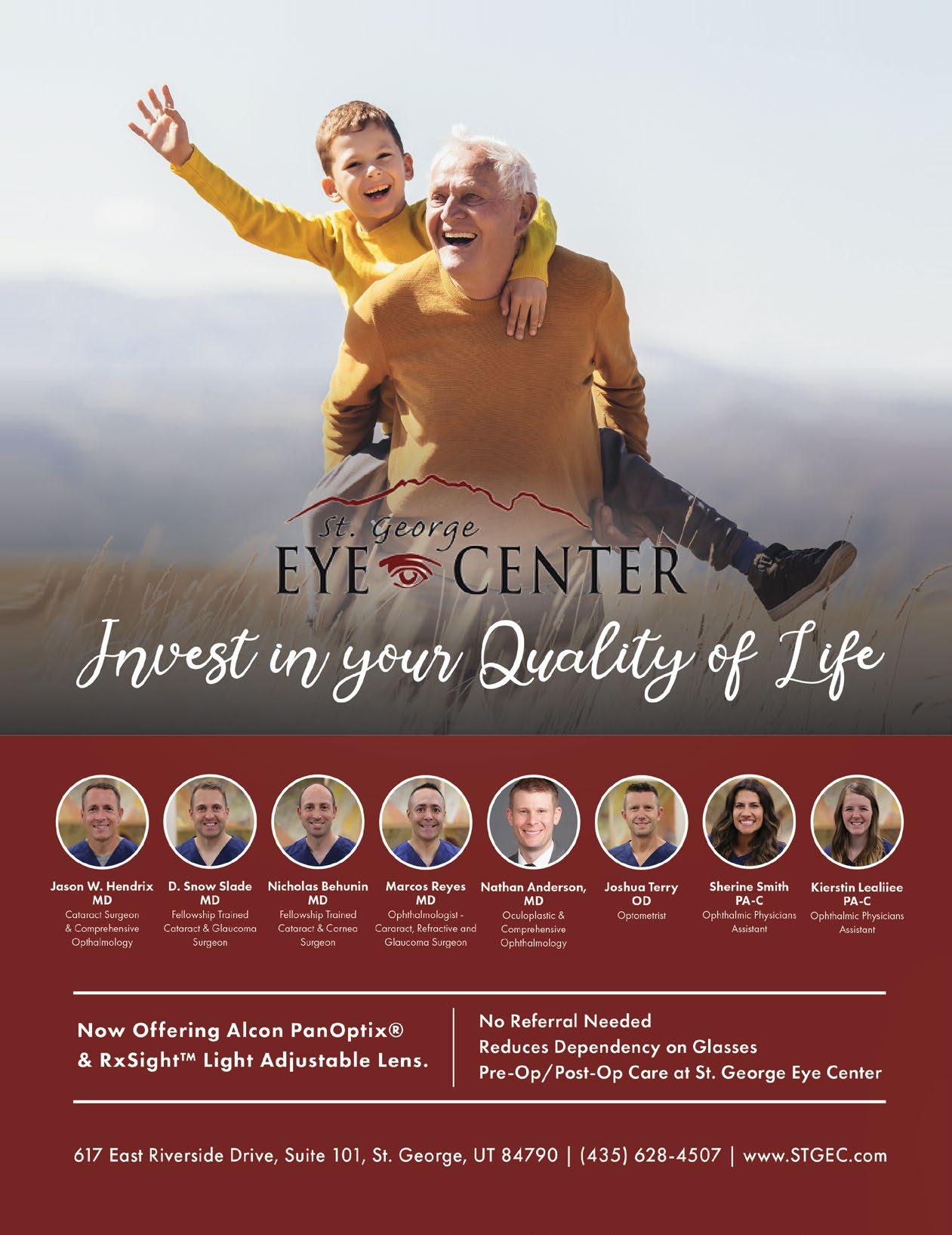
The way we talk about sexual violence matters. Our words can be used to foster a culture of safety, respect, and equality that stops sexual violence before it happens. Or to show support for survivors, shutdown harmful misconceptions, promote consent, and to practice healthy communication with children. Our voices matter now more than ever. How will you use yours to help end sexual assault, harassment, and rape? DOVE Center is our local resource for those who have experienced domestic abuse and sexual assault. DOVE can help. Please reach out.

The way we talk about sexual violence matters. Our words can be used to foster a culture of safety, respect, and equality that stops sexual violence before it happens or to show support for survivors, shutdown harmful misconceptions, promote consent, and practive healthy communication with children. Our voices matter now more than ever. How will you use your voice to help end sexual assault, harassment, and rape? DOVE Center is our local resource for those who have experienced domestic abuse and sexual assault. DOVE can help. Please reach out.
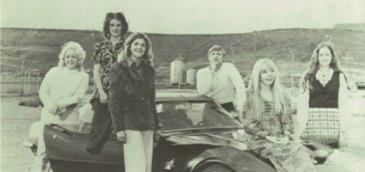






6 www.sghealthandwellnessmagazine.com Health and Fitness Learning to Like Healthy Foods 16 The Greatest Chemical Laboratory ........ 24 Functional Fitness Will Help You Reach Your Goals ........................................ 26 Get Back to It..................................................... 31 Sacroiliac Joint Pain and Innovative Treatments ................................. 37 Intermittent Fasting: Good or Bad 38 Tips for Making Your Home Healthy for Your Pets .................................................... 40 Advancements in Dental Medicine 50 Non-Sugar Substitutes 53 Tips for Enjoying Fall Hikes to the Fullest 60 Rescue Alert of Dixie, Providing Independence and Peace of Mind 67 Eye Health: Facts and Fictions 68 Trimming Down? The Science Behind Saving Dessert for Last 70 Mind and Body The Psychological Benefits of Exercise .... 14 Self-Care and Mental Health 28 Healthy Risk Taking Helps Young People Thrive .................................. 48 Trauma Rewires Brain Patterns; You Can Change Them Back................... 56 Strengthen Your Intuition 58 Applying the Law of the Harvest for Abundant Living .................................... 64 Five Healthy Habits to Help Reduce Stress .................................................. 72 Featured Story The Greatest Chemical Laboratory .............. 24
Community and Culture Letter from the Editor 7 Mayor’s Message 9 Trailblazer Nation: Letter from the President 10 DTC: The Force That Drives Us to Excellence ............................................................. 12 The Stigma of Mental Illness: Why We Need to Talk about It 18 Take It from the Pro 20 A REALTOR® is the Expert 22 I Found My House! Now What? ................... 30 Take the Jump: Mentor a Child ...................... 32 Believe in the Magic of Christmas 34 Angelica’s Mexican Grill: Delicious, Different, and Fresh Are What They Do............................................. 42 From Passion to Profession: A Utah Tech Student’s Journey to NCIS 44 Retire on Purpose: When You’re 6’11”, It’s Hard to Blend In .......................................... 62 Maximizing Retirement Savings 65 Abby Terry: Participating in the Performing Arts Helped Me Find Great Friends .......................................................... 69 TABLE OF CONTENTS sghw | WELLNESS The opinions, beliefs, and viewpoints
the opinions, beliefs, and viewpoints
St.
Health & Wellness Magazine, its owners,
its staff. Relationships and Family Oh, How Time Flies 46 As Soon As... 54 SEPTEMBER/OCTOBER 2023 On The Cover: The Psychological Benefits of Exercise 14
expressed by the various authors and forum participants in this magazine do not necessarily reflect
of
George
or
I have always been a bit of an adventurer. With my camera in hand and my drone strapped to my back, I love going out to explore new places and capturing that perfect photo.
You need to know that for the most part, I really do like being around people, but sometimes, I need to go somewhere where I’m alone. Being outdoors and exploring nature with my camera gives me a chance to regroup and has become a way I cope with anxiety and stress. I figure there are worse ways in life to unwind.
I have learned that when I am feeling overwhelmed, it is absolutely imperative that I go visit some trees and rocks. Being alone in the outdoors has a positive impact on my mental health. What is more, I find I am happier and living a more fulfilling life when I spend time enjoying nature. When I take off for an afternoon of hiking, I am not escaping and avoiding; I’m clearing away negative emotions and boosting my emotional well-being.
If you’re someone who is on the fence about hiking, you might want to give it a second chance as there are so many mental and emotional benefits to a long walk in the outdoors. For starters, hiking:
• Releases endorphins that reduce stress and anxiety.
• Helps to reduce muscle tension, headaches, and fatigue.
• Improves your overall mood.
• Makes you feel more positive.
• Reduces symptoms of depression.
• Increases self-esteem.
• Raises your self-confidence.
• Improves sleep.
• Increases energy levels and reduces fatigue.
• Improves cognitive function.
If you’re struggling with anxiety or experiencing high levels of stress, try going on a hike. It may just be the thing that helps you to find your happy place. The best part is (at least for me) trees and rocks don’t talk back to you!
Happy hiking.
Brendan Dalley Editor Brendan Dalley Editor

St. George Health & Wellness Magazine | September/October 2023 7 FROM THE EDITOR sghw | WELLNESS
For information on advertising or other inquiries, visit our website at www.sghealthandwellnessmagazine.com, email diane.sghealth@gmail.com or call us at (435) 236-2966.



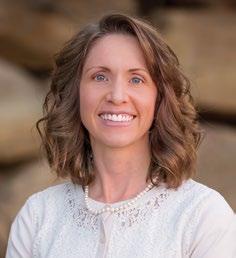
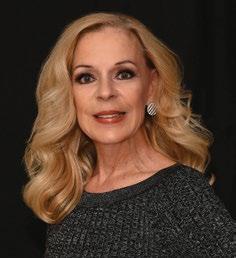
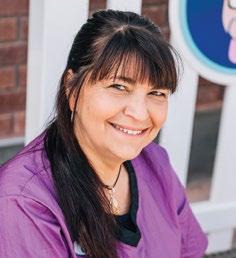
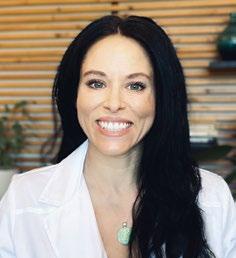
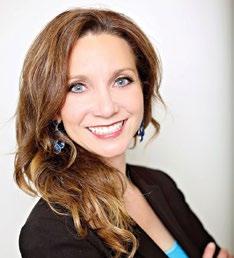

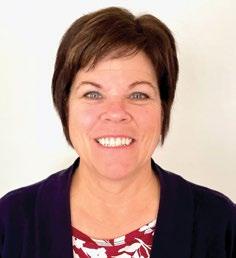



The publisher is not responsible for the accuracy of the articles in St. George Health & Wellness Magazine. The information contained within has been obtained from sources believed to be reliable. Neither the publisher nor any other party assumes liability for loss or damage as a result of reliance on this material. Appropriate professional advice should be sought before making decisions. Outside of our staff authors, articles written by providers or professionals are invited authors and represent the opinions of that particular individual, business, group or organization. If an article is a paid advertisement, we will place the word “Advertisement” or “Advertorial” to identify it as such. ©Copyright 2023.
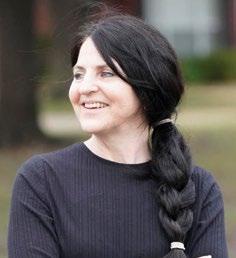


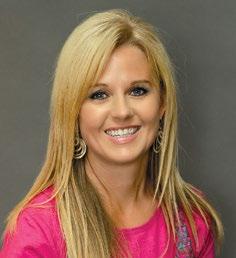

MEET OUR STAFF sghw | WELLNESS
Gini Grimsley, Director of Fitness Product, VASA Fitness Author, Health and Fitness
Tiffany Gust, MS, NBC-HWC, USA Triathlon Certified Coach Author, Health and Fitness
Brendan Dalley Executive Editor
Koby Taylor, PharmD Executive Editor, Author
Diane K. Del Toro Director of Operations, Copy and Design Editor
Scott Allen, MD Author, Health and Wellness
Brigit Atkin Author, Mind and Body
Jessica Elgin Author, Economic and Financial Health
Erin Del Toro, ACHE Clinical Hypnotherapist Author, Mind and Body
Anita DeLelles, LMT, LAMT Author, Pet Wellness
Lyman Hafen Author, Community and Culture
Rob Henderson, LASUDC, CTRS Author, Mind and Body
Marianne Hamilton Author, Community and Culture
Annelies Newman, RDN, CD Author, Nutrition and Healthy Eating
L. Steven Wilson Author, Purposeful Living
Matt Eschler, PhD, LMFT Author, Relationships and Family
Chris Eschler Author, Health and Well-Being Life Coach
8 www.sghealthandwellnessmagazine.com
William Plumb, DDS Author, Oral Health
MAYOR’S MESSAGE

Once a year, on a picturesque morning, I like to stand in the middle of 300 South holding a banner while the crowd around me cheers. Just thinking about it gives me the chills. But they aren’t cheering for me.
I’m talking about the St. George Marathon. Each year on the first Saturday of October, thousands of runners take part in what has become our signature event. At the finish line, I get to hold the tape while hundreds at Vernon Worthen Park yell boisterously for the winners. It’s one of my favorite duties as Mayor of St. George.
This year, more than ever before, the marathon event has opportunities for people of every ability. In addition to the marathon that is scheduled for October 7, there is the St. George Half Marathon held the same morning. There is also the 5K race, kids division, and adaptive division on October 6. There is something for everybody!
If you hang out at the finish line, you will see the three components of the race come together.

For runners, marathon day is the culmination of sweat, determination, and for those who live in St. George, early morning summer runs to beat the heat.

For staff, marathon day is the result of months of preparation, logistical stress, lost sleep, and a sense of duty.
For volunteers, marathon day provides a fun, purposeful, heart-warming, and satisfying way to spend an October morning.
These three groups inspire me every year, bringing to life our city’s twin pillars: activity and optimism. Thousands of people come here to take part in the marathon. These visitors often report that their favorite memory of St. George is the kindness and helpfulness displayed by our volunteers. Let’s show our Dixie Spirit and rally together again as a community.
There are so many volunteer opportunities. You can support an aid station, hand out packets at the Dixie Center, work the clothing retrieval area, or help “catch” runners at the finish line. Go to stgeorgemarathon. com/volunteerregistration and see what interests you.
of marathon.
If you can’t quite swing that, join me at the Mayor’s Walk, a breezy one-mile trip from Historic Town Square to the finish line at Vernon Worthen Park the morning of the marathon. You probably won’t hear the same type of cheering that winners of the marathon receive, but you can enjoy a sense of accomplishment and feel love from the community.
Mayor, City of St. George
St. George Health & Wellness Magazine | September/October 2023 9
I am thrilled to announce that as part of a landmark partnership, Dixie State University and the Greater Zion Convention & Tourism Office have entered into a strategic marketing agreement that will result in Greater Zion receiving more than $2 million in annual marketing exposure and Trailblazer Stadium being renamed Greater Zion Stadium.
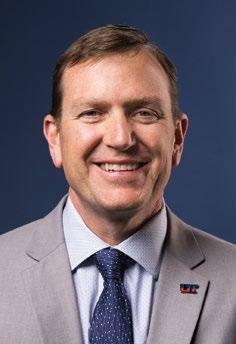
This year, Utah Tech University is celebrating ten years of university status. What an amazing decade of growing, learning, and serving our community it has been!

Soon after becoming a university, we met with hundreds of community members to learn what they needed from their local university. We quickly learned there was a great need for prospective employees trained in business, technology, and health care so these industries could thrive in southern Utah and graduates could stay in St. George. Prepared with this information, we began creating our polytechnic academic model, which features hands-on learning and career preparation, as well as building the academic programs, facilities, and student services necessary to be an open, inclusive, comprehensive, polytechnic university.
The 20-year, $10 million agreement maximizes revenue generated by visitors—not Washington County taxpayers—to create a superior experience for both visitors and residents. The partnership is truly a win-win-win situation for everyone; it promotes the area nationally, builds the community, and fuels economic growth by bringing more people to our gorgeous corner of the world.
In the last decade, Utah Tech University has added 204 academic programs. As a comprehensive University, we offer transformative experiences across all disciplines— humanities, arts, education, health sciences, business, and STEM—with the most affordable university tuition in Utah. Making college even more affordable, we nearly doubled funds awarded to students from $10.4 million to $19.8 million over the last decade.
As part of this effort, the Tourism Office will establish a visitor center at the stadium and information kiosks at other key locations on campus to showcase visitor activities to all those who attend events on the Dixie State campus. Additionally, Dixie State will better be able to tell prospective students what an amazing backyard full of abundant recreational opportunities they will have when they attend DSU.
To accommodate the influx in students, Utah Tech University built or renovated twenty-eight buildings in addition to parking and outdoor facilities throughout the last ten years. In addition to providing students with state-of-the-art labs and learning spaces, these additions have allowed the University to host more community events, such as annual spring, 4th of July, Tricks and Treats, and tree lighting celebrations. As a committed community partner, we also started the City Alliance Project in which we’ve partnered with St. George, Santa Clara, and Springdale to help create solutions to municipalities’ challenges. Our Atwood Innovation Plaza also opened in the last decade and has helped the community
The timing of this partnership couldn’t be more perfect, as it will assist Dixie State during our transition to NCAA Division I status through opportunities to expand athletic facilities. The university plans on adding state-of-the-art press boxes and comfortable event space to the existing westside grandstands, which will help attract more athletic, entertainment, and community events. As a member of the
with approximately 200 patent applications, twenty copyrights, 100 registered trademarks, and the creation of sixty businesses.



Western Athletic Conference
starting this July, Dixie State will take on competitors based everywhere from Washington, California, Arizona, and New Mexico to Illinois, Missouri, and Texas. This will give Greater Zion access to audiences it would otherwise leave unreached.
As we implemented these initiatives, students started to notice the quality and value of an education from Utah Tech University. In fact, in the last decade, enrollment has increased by 50 percent from 8,350 to 12,556 students. Not only are more students coming to Utah Tech, more are finishing their degrees. The number of degrees awarded has increased by 60 percent as the University has bestowed 24,409 degrees since 2013.
 Richard “Biff” Williams President of Dixie State University
Richard “Biff” Williams President of Dixie State University
Students aren’t the only ones noticing this growth. Among numerous national awards, most recently, Utah Tech University was named to Higher Education Digest’s list of “10 Prominent Universities and Colleges to Watch in 2023,” Education Insights Magazine’s “10 Most Admired Universities,” and The Education Magazine’s “10 Most Prominent Arts and Science Colleges.”
Plus, partnering with Greater Zion is a natural fit for Dixie State University. The Tourism Office’s vision to “Inspire Greater. Experience Greater. Live Greater.” aligns perfectly with Dixie State’s “active learning. active life.” approach to education. Both philosophies take advantage of the beautiful, world-renowned destination we live in by encouraging students, visitors, and residents alike to learn by exploring. Here at the University, we recognize that valuable learning experiences take place inside and outside of the classroom. By taking advantage of experiences available in Greater Zion, we all can grow academically, actively, and holistically.

This unique, trailblazing partnership certainly will enhance our community for years to come. I can’t wait to see you at upcoming games, concerts, and community events in Greater Zion Stadium!
To learn more about these accomplishments and others, please join me at Utah Tech’s annual State of the University Address on Wednesday, September 20, at 11 a.m. on campus in the M.K. Cox Performing Arts Center. This will be a great opportunity to celebrate the milestones our community’s University has achieved over the last decade. These past ten years have shown that working together to offer our community quality educational opportunities makes every day a great day to be a Trailblazer!
10 www.saintgeorgewellness.com www.sghealthandwellnessmagazine.com 10 www.saintgeorgewellness.com
TemplateMOD.indd 1 4/17/17 11:08 AM SGHW_2020_MarApr_FINAL.indd 10 3/3/20 5:43 PM
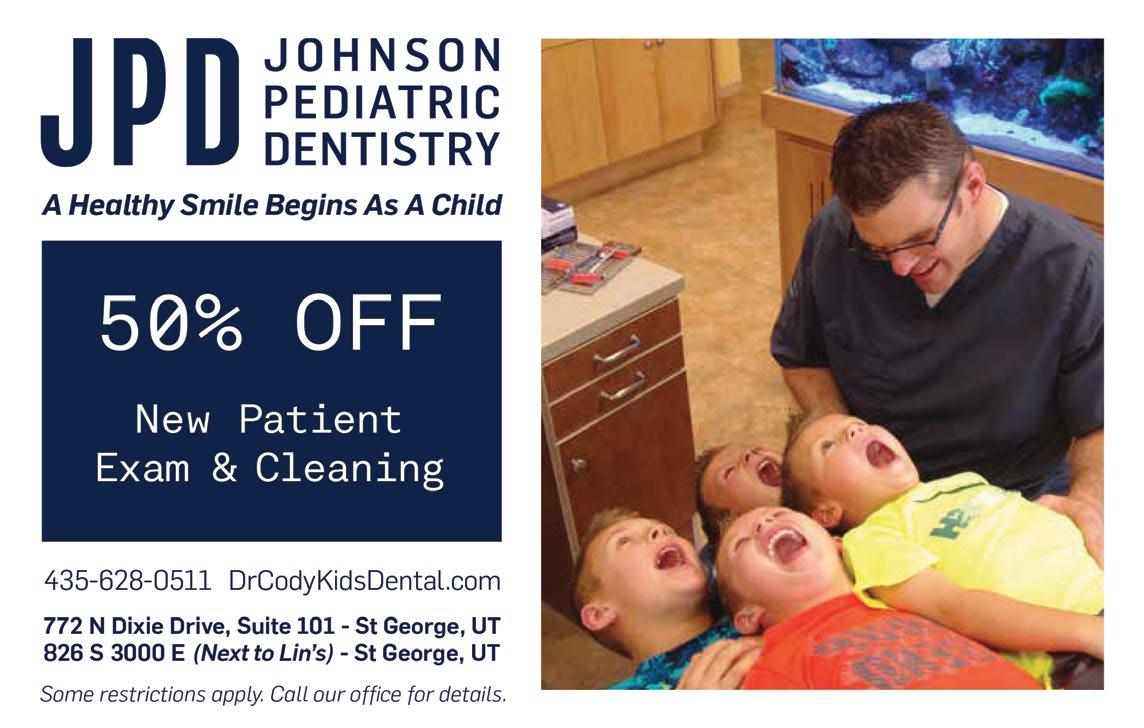





St. George Health & Wellness Magazine | September/October 2023 11 EYECARE and OPTICAL CARE DOCTORS IN SOUTHERN UTAH MOST AWARDED You’re invited to a FREE Dry Eye Seminar RSVP by calling today at DATE: October 4th, 2023 TIME: 6:00pm–7:00pm VENUE: SouthWest Vision 965 E 700 S, Ste 100 St. George, UT 84790 965 E. 700 S. Ste. 100, St. George 435-673-5577 www.SouthWestVision.com DOCTORS IN SOUTHERN UTAH FOR EYECARE and OPTICAL CARE MOST AWARDED 10 15 435-673-5577
PRESIDENT’S MESSAGE
Our dedicated, hard working students were able to obtain the best graduation rate throughout the state of Utah. 81 percent of our students graduated and received their certificate of completion along with licenses and industry-specific certifications that they can take directly into the workforce.
The success of our students is not solely measured by the number of students who walk across the stage at graduation; it lies in the progress each student makes during their time at Dixie Tech. Each of our courses focuses only on the skills and materials that are needed to help students thrive in their chosen career. Most programs can be completed in as little as one year, and some can be completed in as little as four weeks. Each hour invested by our students is the training that will lead to a brighter future and a more skilled workforce.
By Jordan Rushton, President, Dixie Technical College

The Force That Drives Us to Excellence
As we transition into the 2023-2024 school year, Dixie Technical College takes great pride in commemorating the remarkable dedication and achievements of our students and community over the past year.
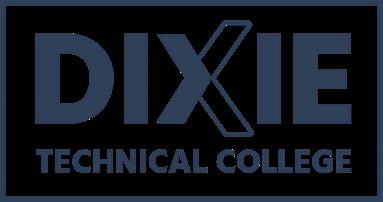

Education in any of its forms is a vital component in obtaining a fulfilling career. At Dixie Tech, our mission is to train students to master essential skills that they can take directly to the workforce. Education can enable students to support their families, strengthen the community, contribute to local industry, and at the same time, help them advance in their career.
This year, 1,696 individuals chose to enrich their education and start their journey towards a career by participating in the programs offered at Dixie Tech. The increasing number of students year after year shows the dedication and determination of the members of our community.
With the elevated enrollment and interest in programs at Dixie Tech, we are expanding to include courses in Full Stack Web Development and Mobile App Development for both IOS and Android. The growing interest in our programs resulted in over a dozen new cohorts being opened across various areas of study. We expanded availability in key programs, such as Commercial Driver’s License Class A, Electrical Apprenticeship, HVACR Technician, Practical Nursing, Medical Assistant, and Nursing Assistant. We’ve also included more accelerated, four-week, and high school cohorts for our Nursing Assistant Program. This expansion ensures that students have the opportunity to access the education and training they need to excel in their chosen fields.
Alongside the remarkable accomplishments of our students was the support from the community as a whole. Throughout the school year, our community donated over $60,000 towards student scholarship funds. We strive to help our students graduate debt free and were able to assist our students in receiving over half a million dollars worth of scholarships and federal financial aid throughout last year.
The past year has been a transformative one for Dixie Technical College. With increased enrollment, expanded programs, and valuable partnerships, we continue to be grateful for the role we play in training Southern Utah’s workforce and changing

12 www.sghealthandwellnessmagazine.com

SICKNESS & INJURIES DON’T ALWAYS HAPPEN DURING BUSINESS HOURS For non-life-threatening conditions, visit our St. George Urgent Care 2825 East Mall Drive St. George, Utah 84790 In addition to treating standard issues, we can help with more complex issues, such as • Orthopedic issues like broken bones or sports injuries • Wound Care • Mental health-related issues • Heat stroke or dehydration • UTIs or catheter care • Kidney stones Mon-Sat: 8am-8pm Sun: 8am-5pm Labs & Imaging also available • 435.673.6131
The Psychological Benefits of Exercise
 By Diane Del Toro
By Diane Del Toro
Most people know the many physical benefits of exercise: weight control, lower blood pressure, reduced risk of diabetes, and increased energy, just to name a few. But what about the mental and emotional benefits of exercise?
Consider the experience of my long-time friend, Alex. After his business closed during the COVID-19 pandemic, Alex struggled with mild depression. As time passed and he was unable to find employment, his days became filled with a sense of emptiness and hopelessness.
A neighbor invited Alex to attend a yoga class with her, suggesting it might help him cope with his depression. At first, Alex was hesitant; he did not believe he could find solace in something as simple as exercise. However, something inside him urged him to give it a try.
As the class progressed, Alex found himself following the instructor’s guidance, attempting various poses, and focusing on his breath. As the class ended, he was surprised to realize that for the first time in a long while, he felt a sense of detachment from the heavy burden of depression. The feeling was brief, but it left him with a spark of hope.
In the following weeks, Alex continued attending the yoga class regularly. Each session seemed to chip away at the walls depression had built around him. The instructor’s positive energy and the support of his fellow classmates created a safe space for Alex to explore and confront his emotions. With time, he discovered that exercise was not just about physical health but also about nurturing his mental well-being.
Encouraged by the progress he was making through yoga, Alex decided to expand his horizons and try other forms of exercise. He began going for daily walks and jogging around the park. He even enrolled in a local dance class. The endorphins released during physical activity gradually began to replace the gloom with a newfound sense of joy and accomplishment. For Alex, a simple step onto a yoga mat led to a life-changing journey of healing and self-discovery.
Exercise can be a powerful ally in beating “the blues” or feelings of sadness and low mood. From easing symptoms of depression and anxiety to keeping your memory sharp, there is no shortage of psychological benefits to exercise.
“It’s a very potent intervention to be physically active,” said Anders Hovland, a clinical psychologist at the University of Bergen in Norway. In 2016, Hovland and his colleagues searched medical journals and published research literature, identifying 977 participants in twenty-three clinical trials that tested the effectiveness of exercise in treating depression. Their study, “Exercise as a Treatment for Depression: A Meta-Analysis,” was published in the Journal of Affective Disorders. The study concluded that “physical exercise (was) an effective intervention for depression…and could be a viable adjunct treatment in combination with antidepressants.”
14 www.sghealthandwellnessmagazine.com
According to Bret Gordon, exercise psychology researcher at the Penn State College of Medicine, exercise offers some advantages over antidepressant medications. For starters, it can improve mood almost immediately while antidepressant medications take between several weeks to several months to be fully effective. Additionally, exercise can counteract one of the side effects found so unpleasant by antidepressant users: weight gain. “Many people who have mental health concerns are not enthusiastic about starting a medication for the rest of their lives and are interested in pursuing other options. Exercise might be one of those options,” said Jacob Meyer, exercise psychologist at Iowa State University.
Finding the inner strength to begin a new routine might be difficult for those struggling with anxiety, depression, grief, loneliness, or other mental or emotional challenges. Start slow, as Alex did, and work into a consistent, daily exercise program. Remember that exercise doesn’t have to be intense or time consuming to be beneficial. Even moderate physical activity, such as walking, riding a bicycle, or dancing, can have positive effects on mood. The key is consistency and finding activities that bring enjoyment and fulfillment.
If you are experiencing persistent feelings of sadness, hopelessness, or depression, it’s crucial to seek support from a healthcare professional or mental health provider. Exercise can be a valuable part of a comprehensive approach to managing mental health, but it may not be sufficient as the sole treatment for clinical depression or more severe mood disorders.
If you need motivation to get to the gym or to go for a brisk walk, the eleven psychological benefits of physical activity listed below may motivate you to put on your walking shoes and head out the door.

Mental and Emotional Benefits of Exercise
Endorphin Release: Exercise triggers the release of endorphins, which are natural chemicals in the brain that act as mood lifters and pain reducers. These endorphins create a sense of euphoria and well-being, counteracting feelings of sadness.
Serotonin and Dopamine Boost: Exercise increases the levels of serotonin and dopamine in the brain. These neurotransmitters play a crucial role in regulating mood, and their enhanced presence can help alleviate feelings of depression and anxiety.
Stress Reduction: Physical activity is an effective stress reliever. It helps reduce the levels of stress hormones, such as cortisol, in the body, leading to a calmer mind and a more relaxed state.
Distraction and Focus: Engaging in exercise provides a break from negative thought patterns and rumination. Focusing on the activity at hand can redirect the mind, allowing for a temporary mental respite.
Improved Self-Esteem: Regular exercise, especially when progress is made, can boost self-esteem and confidence. Accomplishing fitness goals and feeling more in control of one’s body can have a positive impact on overall self-image.
Social Interaction: Participating in group exercise classes or activities can foster social connections, reducing feelings of isolation and loneliness that may contribute to anxiety and depression.
Better Sleep: Exercise can promote better sleep quality, leading to improved energy levels and a more stable mood during the day.
Mind-Body Connection: Engaging in activities like yoga, tai chi, or mindful walking can strengthen the mind-body connection, promoting a sense of inner calm and balance.
Neuroplasticity: Regular exercise has been linked to increased brain plasticity, allowing the brain to rewire and adapt positively. This can lead to improved cognitive function and emotional well-being.
St. George Health & Wellness Magazine | September/October 2023 15
About the Author
Annelies Newman, RDN, CD, received her bachelor’s degree from Brigham Young University with a major in nutrition and dietetics and a minor in music. She is a speaker and presenter on nutrition related topics. Currently, she owns a private practice guiding individuals to make changes for better health and wellness. On the side, she enjoys adventuring with her husband and three little boys outdoors. She believes that real food is good for the body and should be enjoyed!

Learning to Like Healthy Foods
By Annelies Newman, RDN, CD
Have you ever tried to change your diet or try a new, healthy food only to find yourself saying, “I don’t like it” (or as my two-year-old says, “No, taste yucky”). Often these reactions to a new food put on the brakes for trying again.
Taste preferences are considered the second driver of food selection, with the first driver being convenience. Thus, the way food tastes is a major reason why we eat the foods that we do. It can also be a major barrier if eating healthier “tastes yucky” to you.
The barrier is not so much in having taste preferences but in how we view taste preferences. If we view them as unalterable, then we can be stuck in them. We may not offer a food item to our child or family member again if the first exposure was met with a firm, “I don’t like that.” Or maybe we individually have “never” liked a certain vegetable, fruit, or whole grain item and thus aren’t willing to ever taste it again simply because of this firm belief.

Well, let’s shed some light on this ever-present problem, especially if you are feeding others. Taste preferences are learned and can be changed with repeated exposure. Our likes and dislikes are
developed over a lifetime of experiences with food. I have made the mistake of trying new recipe after new recipe in hopes of finding that golden combination of flavors so my children would start eating beans. I finally stuck to a recipe I personally liked, offering it frequently and repeatedly enough for them to “learn” to like it. It has now become a family favorite.
Research shows that the number of times required for a person to be exposed to a particular food before liking it is faster in infancy and slower in adulthood. Infants may require one to five exposures before liking a food. Preschoolers to school-age children require between five and fifteen exposures, and adults may require twenty times or more. But remember, learning to like a new food is not impossible at any age. We can all learn to like new foods.
Not liking a new food at first should be viewed as part of the learning process. I have watched as one child chewed up carrots only to spit them out again, day after day. I thanked him for trying and praised him for chewing it up….After all, he was tasting!
16 www.sghealthandwellnessmagazine.com
Most parents (including myself, at times) give up on serving some food items if the first or second exposures were not successful enough. I have been there, and it certainly can be frustrating. Changing our own beliefs and seeing these moments as part of the learning process and as successes, not failures, can help change the emotional responses we have towards tasting. It also allows the process to continue on to success.
What does “frequently” look like? Well, it’s definitely not one to two times per month. We need to be exposed to a new food—even with at least a grain-sized amount—frequently enough to become familiar with it over time. The size of the taste or the number of tastes in one sitting are not important; frequency of exposure is. So having even a very small taste of a food we are learning to like can have a positive influence and can prevent issues like gagging or feeling excessively pressured during this process.
There are other strategies that can be used. For example, hunger is a strong determinant to increasing the willingness to try new foods. As such, remove snacking or grazing to encourage better

tasting at the table when it is time for a meal. You could also use flavors that have already been accepted, like dressings or spices, to increase the willingness to try. And finally, use language that encourages without being coercive; individualized positive reinforcement is always helpful.
You may come up with your own ideas and ways to begin this process. Remember that it is worth the effort. Enjoying and preferring the taste of healthy foods is a powerful motivator for long-term, healthy eating.
The information in this article was developed from a webinar presented by Keith E. Williams, PhD. He is the director of a feeding program at Penn State Hershey Medical Center and a Professor of Pediatrics at Penn State College of Medicine. His webinar can be accessed here: https://www.youtube.com/watch?v=VfIerqR89dE
St. George Health & Wellness Magazine | September/October 2023 17
The Stigma of Mental Illness: Why We Need to Talk about It
 By Matthew Linton, PhD
By Matthew Linton, PhD
As the hours of daylight slowly shorten and we move toward winter and the holidays, it becomes increasingly common for some of us to struggle with our mental health. Poor mental health, including anxiety and depression, is a leading health problem in the United States, and for many, it only worsens as winter approaches. Not too long ago, humans were usually more concerned about having enough food and fuel for the winter, but those concerns seem to have largely given way to an increased risk for poor mental health, at least among the affluent nations of the world. The reasons for this decrease in emotional and mental health are poorly understood and puzzling but appear to be connected to many social, environmental, and biological factors. Regardless of any debate around the causes, there should be no question that depression and anxiety are real, are probably here to stay, and need to be addressed.
For many, there seems to be stigma or embarrassment around admitting that one is struggling emotionally or mentally. Why is that? If someone at work asked how I
ROCK Y VISTA UN IV ER SI TY
was doing and I happened to have a throbbing headache at that moment, I probably wouldn’t hesitate to let them know. In fact, after letting them know, they would probably respond with, “I hate headaches. I have some acetaminophen for that. Would you like some?” That sort of exchange with friends seems very reasonable. So why does sharing our struggles with depression or anxiety seem any different? Perhaps the reluctance to share the state of our mental health is connected to the poor responses we have received in the past, such as the suggestion that we should “just snap out of it” or the lingering hint of “How could you be depressed? You have everything going for you, and your life seems perfect!” But this is where our logic is wrong. Although depression and anxiety are certainly connected to how we live and what we do, they are also very much a result of our brain chemistry—over which we have almost no control. In other words, our mental health is often more a product of our neurobiology than the balance in our bank account or how awesome our life may be perceived by an outsider.
Certainly, any shame, embarrassment, or hesitation to talk openly about our mental health with friends and family needs to
end. We need to give others the space to share their feelings, thoughts, and struggles surrounding their mental health and to listen and believe that their pain is real. After all, mental health is just another side of our health and like a stomach ache or the need for reading glasses, should be discussed openly and without judgement. So my gentle advice is to not be afraid to discuss your mental health with family, friends, and colleagues, especially as we move into winter and the holiday season. Additionally, we should make every effort to be attentive to others in their own emotional struggles and actively listen to those nearby when they express their emotional challenges and pain. As we share—and listen—we will not only help remove the stigma surrounding mental health, we will also help ourselves and others.
About the Author Matt Linton, PhD, is a physiologist and former Assistant Dean at the Rocky Vista University College of Osteopathic Medicine in Ivins, Utah. He is a native of Utah and enjoys backpacking, playing his guitars, and spending time with his wife and children.

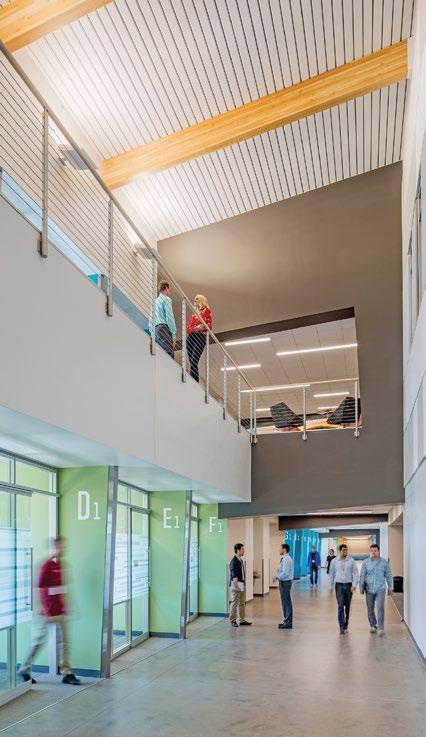
18 www.sghealthandwellnessmagazine.com
At Rocky Vista University we believe that a career in medicine is not just a job but a calling. We are committed to providing our students with the knowledge, skills, and experience required to become competent and compassionate physicians who make a difference in the lives of their patients. If you share our passion for osteopathic medicine and are looking for a supportive and interactive learning environment, we invite you to consider Rocky Vista University.

Three Campus Locations:



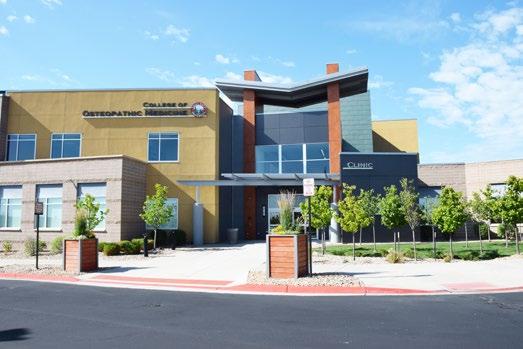

Snac t o r equest moreinformation
RVUCOM - Parker, Colorado
RVUCOM - Ivins, Utah
MCOM - Billings, Montana
Take It from the Pro: Rob Krieger Serves Those Who Have Served Via PGA Hope
By Marianne Hamilton
Rob Krieger has never worn a military uniform. But that doesn’t stop the PGA Director of Instruction at Southgate Golf Club from doing everything possible to help those who have served their country. Not surprisingly, Krieger chooses to do so through the game of golf.
In September, Krieger will begin another clinic session of PGA HOPE (Helping Our Patriots Everywhere), the flagship military program of PGA REACH, PGA America’s charitable foundation. PGA HOPE participants are military veterans, especially those dealing with physical, mental, and/or emotional disabilities. Over the course of eight weeks, they learn golf fundamentals that get them playing on a course. But most importantly, vets who take part in the program connect with other vets and develop a community that understands the unique challenges they often face after returning to civilian life.
Krieger added that PGA HOPE makes golf accessible to any interested veteran, specifically those who are disabled, as well as those who’ve never played the game or who haven’t swung a club in many years. Thanks to funding through the PGA and donations from generous community members, vets can learn new (or improve older) skills, completely free of charge.
“The vets pay nothing for instruction, and clubs and equipment can be provided for those in need,” Krieger confirmed. “It can be a big hurdle to get started, so we take donations of used clubs and bags all the time, and they go to our vets along with a PGA HOPE shirt and hat. Anything we can, we give.”
A few of the twelve veterans who took part in the spring session of PGA HOPE this year became so enamored with the game—and so excited to meet and bond with fellow brothers-in-arms—that they subsequently purchased their own sets of clubs, returning their starter sets to Krieger. “They’ll stop by and say, ‘I got some new equipment; please give mine to another vet,’ which is definitely cool,” said Krieger.
Krieger is the first PGA pro to host a PGA HOPE program in Utah. After learning of the initiative several years ago, he was eager to bring it to St. George.

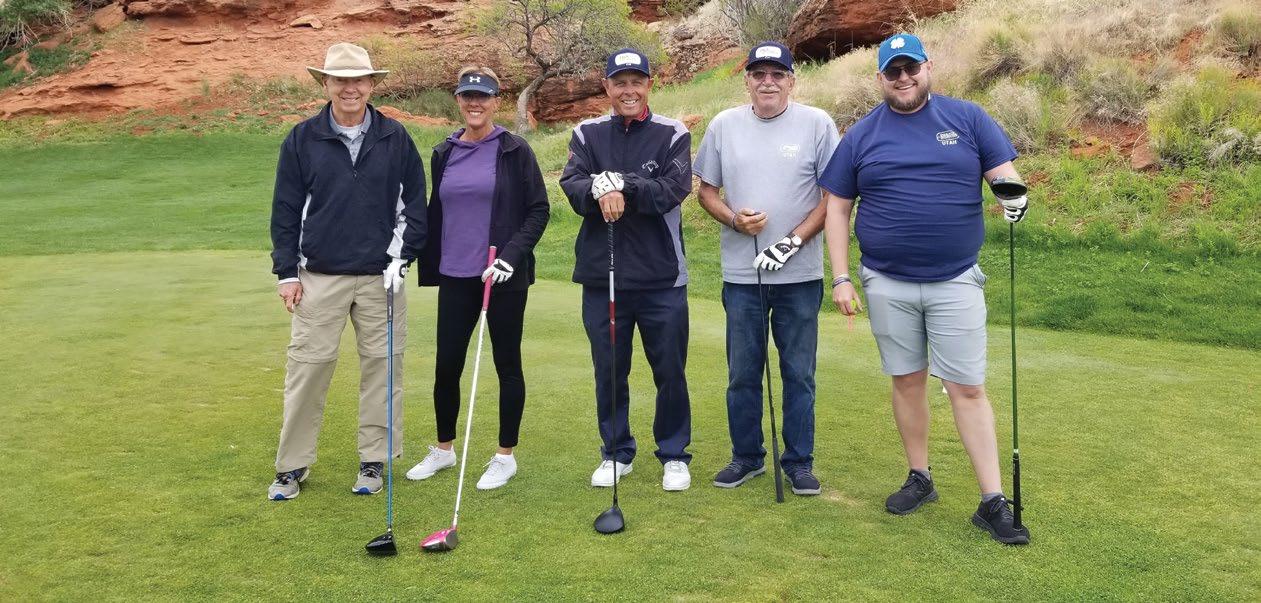
“We have a large base of retirees here, and quite a few are vets,” Krieger explained. “Some have significant needs; they’re dealing with missing limbs, addictions, suicidal thoughts, or other hardships. Golf is a game you can play regardless of ability or disability. It’s a great healer, so we knew this program would help our local vets.”
One of the beneficiaries of such largesse was Michael McClellan, who has served in the National Guard for the past fourteen years. McClellan, a physician’s assistant at the St. George VA Clinic, had long regarded golf as beyond his financial means. The news that he need not drain his bank account to begin playing was a major enticement to sign up for PGA HOPE. Said McClellan, “I used to think of golf as a ‘rich man’s sport.’ But often it’s not accessible even to middle-class players due to the costs involved. What intrigued me most about the program, both personally and as a healthcare professional for vets, was that I could try golf without dropping $600 or more for clubs and hundreds more on lessons for a game I might never play again.”
Since completing PGA HOPE earlier this year, McClellan has proudly displayed his “diploma” on the wall in his exam room. When vets ask about it, he encourages them to seek out Krieger. “A lot of times vets don’t feel understood because who can really understand what they’ve been through,” McClellan noted. “The goal with PGA HOPE is that you
20 www.sghealthandwellnessmagazine.com
learn to play golf with the friends you make, and then you have a social support system that will help you get through the hard things in your life.”
Karl Watters, Utah Tech Director of Veteran and Military Services, can attest to how vets benefit from PGA HOPE. Having logged thirty years in the National Guard, Watters now offers guidance to Utah Tech students who’ve served in uniform, often informing them about the PGA program.
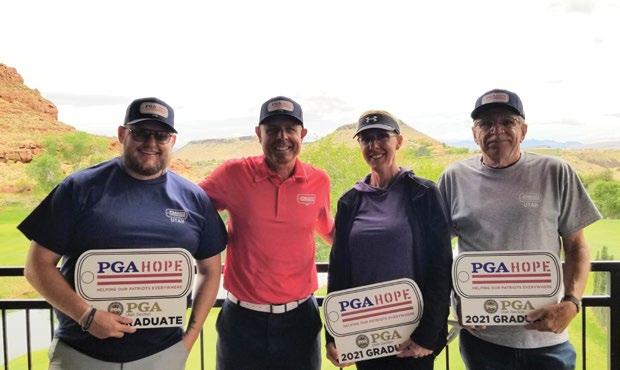

“When I heard about PGA HOPE, it seemed like a win/win,” said Watters. “I could find a new way to help veteran students while improving my golf game. Rob understands military culture as well as anyone who hasn’t served. Sure, there’s some golf talk that goes on in the program; he’s very knowledgeable about the game. But there’s also a fair amount of ‘unlicensed therapy,’ with vets talking to each other and making social and emotional connections.”

Wayne Peterson didn’t precisely qualify for PGA HOPE. An Army veteran, Peterson had emerged unscathed from his three-year tour of duty and has been an avid golfer for decades. But when he heard about the program through a fellow member of the Dixie Elks Lodge, he felt compelled to help Krieger by getting the word out.
“I saw that PGA HOPE would afford training for vets to engage in a sport that would bring them outside and would offer the chance to enjoy camaraderie with other golfers,” Peterson said. Then laughing, he added, “I’m not a pro; my golf game is mired in mediocrity. But working with vets is something I enjoy, and it is something Rob and I have in common. I give him a lot of credit for all that he does.”
With two full groups starting PGA HOPE in September and concluding their training with a nine-hole scramble at Southgate on Veterans Day, Krieger is excited about the future of the program. He encourages community members to drop off usable clubs, bags, and balls and looks forward to hosting all interested vets in the years ahead.
“For people who did so much for all the right reasons, it’s wonderful to be able to offer them something to look forward to that can challenge them mentally and physically,” Krieger concluded. “It’s nice to be able to give back.”
For more information about or to make donations to PGA HOPE, contact Rob Krieger at rob@sgugolf.com.
About the Author
Marianne L. Hamilton is a veteran journalist and marketing writer whose work appears in regional and national publications. When not race walking or teaching water aerobics, she serves on the board of the Art Around the Corner Foundation. She and her husband, Doug, are also coadministrators of the St. George Wine Club, founders and co-directors of the United States Power Walking Association, and race directors for the Huntsman World Senior Games. Marianne was crowned Ms. Senior Universe 2022-2023 and is executive director of the Senior Pageants Group. A proud breast cancer survivor, she is a member of the Intermountain Healthcare Oncology Patient-Family Advisory Council.

St. George Health & Wellness Magazine | September/October 2023 21
A REALTOR® IS THE EXPERT
We all love a good success story—to hear how somebody came out on top when the odds were stacked against them. It’s easy to get caught up in the rush, and that’s no exception when it comes to real estate stories. When somebody sells or purchases a home and saves a bit of cash without using a REALTOR®, it’s tempting to try and do the same, but it’s important to get the facts before testing your luck and forging ahead on your own.
If you’re looking to buy or sell a home in Washington County, take time to understand how using the services of a REALTOR® can save you money and major stress in the long run.
A REALTOR® is an expert. It’s what they do day in and day out, and that experience is worth its weight in gold. With endless reports, critical disclosures, and other crucial documentation, a REALTOR® helps you avoid costly mistakes and oversights. Their guidance removes the stress and places you in the best hands.

When it comes to searching for a home or listing a property, the internet is your biggest tool. If you attempt this on your own, you’re limited to basic public or private listing sites that cost hundreds to thousands of dollars to post a property. A REALTOR® has access to thousands of other agents and properties through the Multiple Listing Service (MLS), which expands your possibilities—especially in a competitive or limited market. They’ll help you get your hands on the hidden gems in Washington County or find the perfect buyers in a stress free process that would otherwise be impossible on your own.

A common complaint from those who have attempted to buy or sell on their own is that they felt at a disadvantage when it came to negotiations. With heavy competition and all cash offers, a REALTOR® with experience is going to ensure success through purchase agreements, inspections, contingencies, and more. They are connected to other professionals throughout the community and have solid working relationships with mortgage brokers, real estate attorneys, home inspectors, and everybody else involved in a real estate transaction, and they will utilize those connections to your advantage.
In a recent study performed by the Utah Licensing Division, 83.6 percent of buyers who purchased within the last twelve months showed high levels of satisfaction with their representative. In that study, trust and experience were the highest priorities for potential buyers, while the cost associated with using a REALTOR® was the least important factor taken into consideration.
While a good DIY project can be fun, attempting to fly solo with real estate can be riddled with stress, major setbacks, and costly mistakes. Make sure you have the support you need, and enlist the expertise of a professional to help you navigate what is undoubtedly one of the largest financial decisions and transactions you will ever make. Set yourself up for success while you take a backseat, and let a REALTOR® do the steering on this incredible journey!
22 www.sghealthandwellnessmagazine.com






St. George Health & Wellness Magazine | September/October 2023 23 157 E Riverside Drive #2A St. George, UT 84790 | Mon-Thurs 9am- 5pm/Fridays 9am -4 pm | 435-628-8738 BUSINESS INSURANCE AGENCY, INC www.StGeorgeInsuranceAgency.com Commercial General Liability Employee Benefits Workers Comp Commercial Auto Renters Home Personal Auto Life
The Greatest Chemical Laboratory
Did you know that you own one of the world’s most complex and fantastic chemical laboratories? It’s true.
Your body is its own complex and fantastic chemical laboratory! Each function of your body is produced by a chemical reaction. This includes everything from your five senses (sight, sound, smell, taste, and touch) to your physiology (the ability to move a muscle, the strength and pace of your heartbeat). Even your psychology and neurology are dramatically affected by this process: feeling sad, angry, or happy; cognition; memory; and sex drive.
Every function of your body is affected by chemical processes. Your entire existence is centered on the effects of your chemical laboratory and its responses.
The chemical reactions we’re talking about happen inside your body but are also influenced by external sources. What you expose your body to will have a massive impact on what it puts out. The food you eat, the air you breathe, and the quality of what you drink are all examples of crucial chemical components that your body is constantly processing. Endless options of potential sources offer hundreds of thousands of chemical compounds. Combining those compounds with your body’s own chemistry creates limitless effects. Who could possibly know how to process such an exponentially vast formula with countless potential variables? You!
Your body already knows what to do. Your job is to provide it with quality ingredients! You will innately source each compound to provide ultimate results within your own unique system. Your body literally formulates its own building and healing elixirs in order to transport them to the places they need to be.
As a result, these diverse chemical formulas are used in millions of ways throughout your body, bringing healing and prevention to every aspect of your health: physical, spiritual/ emotional, and chemical.
The Triad of Health: Physical, Spiritual/Emotional, and Chemical Health
The body’s ability to bounce back from injury, illness, trauma, and other stressors is referred to as resilience. Every single aspect of your health requires resilience in order to thrive. When cared for properly, the human body has the capacity to build resiliency. In other words, your body is armed with the potential ability to heal itself.
Perhaps the most miraculous, amazing thing about resilience is that it already exists within each of us. It is an innate part of our physical, spiritual, and chemical makeup. YOU have the potential capacity to empower your own body to find its own frailties and come to its own aid with its own custom designed solutions. And the best part of your body’s resilience mechanisms is that they come without negative side effects!
Are You Supplying Your Body with Tools for Success?
According to a recent article in the National Library of Medicine, “Each meal brings thousands of different substances into the body, affecting thousands of different biological processes all the way to the cellular and subcellular level. Scientists are only beginning to grasp this enormous universe of food and nutrition effects [emphasis added] on the body.”
When we think of malnourishment, we generally think of not having enough nutritional consumption in our bodies. But when you break the word down, mal-nutrition means improper nutrition. In fact, research shows we are equally likely to be mal-nourished due to an excess of nutrients—too many calories, fats, or isolates, for example.

24 www.sghealthandwellnessmagazine.com
Any form of malnourishment is a contributing factor to disease and its severity. An estimated 44 percent of the world suffers from malnutrition, either by undernourishment or overconsumption. The double burden of malnutrition does not discriminate amongst socioeconomic, cultural, or geographical factors. Both sides of the spectrum can be found in the same country, community, or family. In fact, a single individual may carry both contributing factors of malnutrition simultaneously.
There are many ways to improve the elements that make up your body’s ideal nourishment and encourage ultimate resilience, but I suggest you start small.

Things to Avoid
• Cheap, processed foods
• Processed grains (white flour)
• Excess sugars
• Bad oils
• Empty calories (calories void of nutrient value)
Adulterated foods will quickly clog up and bog down your body machine.
Eat More
• Real foods—the less processed, the better!
• Fruits and vegetables in a wide variety of colors
• Whole grains
• Fruits and vegetables— seven to eleven servings per day
Plant foods are loaded with the natural chemicals your body needs to do its job and optimize your capacity for resilience. Keep the foods you eat raw and pure in their original forms as much as possible. The more whole something is, the better!
Your fantastic laboratory is not only a gift, it is a responsibility. The responsibility to take care of your body is yours and yours alone. You cannot shirk this duty to anyone else. Take ownership of it, and start making the small changes today that will provide massive benefits in your future.
Sources:
“Harnessing the Body’s Ability to Heal Itself.” Duke Health. Accessed July 28, 2023. https://giving.dukehealth.org/why-give/meet-physiciansscientists/harnessing-the-bodys-ability-to-heal-itself.
“Why Our Bodies, and Brains, Bounce Back.” Yale School of Medicine. Accessed July 28, 2023. https://medicine.yale.edu/news/yalemedicine-magazine/article/why-our-bodies-and-brains-bounce-back/.

About the Author
“Building Resilience Through Food.” apps.aaem.org. Accessed July 28, 2023. https://apps.aaem.org/UserFiles/file/WellnessCS17_NovDecWEB-5.pdf.
Birgisdottir, Bryndis Eva. “Nutrition Is Key to Global Pandemic Resilience.” BMJ Nutrition, Prevention & Health, October 14, 2020. https://www.ncbi.nlm.nih.gov/pmc/articles/PMC7841820/#R1.
Dr. Douglas Howard has been actively involved in health care since the age of fourteen. From homeopathy, chiropractics, and medicinal care, Dr. Howard has practiced and studied multifaceted forms of medicine. His dedication has awarded him international recognition and multiple doctoral degrees. As the formulator of Balance of Nature, hundreds of thousands of people worldwide benefit from Dr. Howard’s research. He is a renowned expert in lifestyle disease and has lectured around the world, educating people on the importance of nutrition and its relation to overall health and lifestyle.
St. George Health & Wellness Magazine | September/October 2023 25
Functional Fitness Will Help You Reach Your Goals
By Tiffany K. Gust, MS, NBC-HWC
Is your fitness functional? Is your fitness training helping you to build a body that is capable of doing real-life activities?
Let me explain what I mean by functional fitness with the following hypothetical scenario. Let’s say that you have been going to the gym for months. You’re seeing more definition in your body, and you can bench press more weight than you have ever lifted before. You are shocked when you are injured by lifting a fifty-pound suitcase into your car as you prepare to go on vacation, causing you to spend most of your time off trying to heal a bad back. You can’t imagine spending time in the gym again because you are in so much pain.
Conventional weight training focuses on isolation of muscle groups, but it doesn’t teach the muscle groups you are isolating to work together. The key to functional fitness is muscle integration: teaching the muscles to work together instead of independently.
What is an example of a functional exercise? Think of a bent over row— not the kind of row you do on a seated machine but the kind you do leaning over a bench. Hold the weight in one hand with your arm hanging straight down, then pull the weight up as your elbow points to the ceiling, finishing with your upper arm parallel to the ground.



26 www.sghealthandwellnessmagazine.com
This is an exercise that will build the muscles of the back, the shoulders, and the arms, and because of the nature of the exercise, it will really work your whole body. Compare that motion to a carpenter bending over a piece of wood, a nurse bending over a bed to transfer a patient, or an auto mechanic bending over a car to work on an engine. Anyone doing a bent over row will find a carryover to normal, everyday activities.
Contrast this functional exercise with the seated row where you are sitting in a chair with your chest pressed against pads. As you pull the two levers back, you may be strengthening certain muscles, but your body is not learning anything because you don’t have to activate your core stabilizer muscles or the stabilizers of your arms and shoulders; the machine is doing it for you.
they don’t have the muscular control to do a one-legged squat. They lack the stability and/or the muscles haven’t been trained to work together.
Most of the time in functional fitness, you will be standing on your own two feet and supporting your own weight when you lift anything. Exercises like these will strengthen your core and help you discover your center of gravity; they will also improve your balance and coordination.
How to Get Started in Functional Fitness
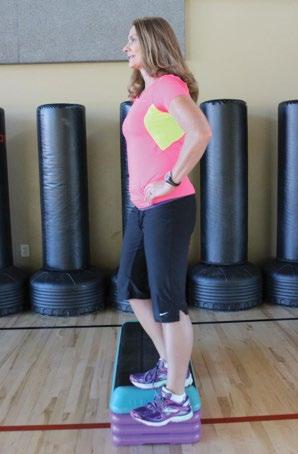

Most people have a hard enough time controlling their own body weight, so you might want to forget about the weights altogether. Try a one-legged squat right now. Can you do it without falling over? Most people can do a leg press with twice their weight, but
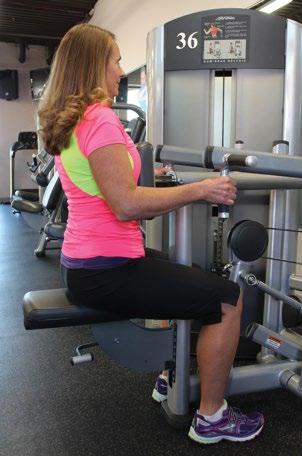
Teach your body to control and balance its own weight. Start with a simple movement, such as the one-legged squat or other balancing exercises. Try standing on a stool that is eight to ten inches high and lower one foot to the ground. Practice controlling your balance while maintaining muscular control. Switch sides to challenge yourself, and integrate both sides of your body.

Functional exercises are more neurologically demanding and require good form. Unlike using the weight machines, the goal isn’t to complete your repetitions to muscle fatigue; it’s to repeat until you can’t continue with good form.
Start slow and work up to more and more repetitions while keeping good form. Before long, you will start to notice that you are able to do more day-to-day functional activities, such as climbing flights of stairs, reaching without pain, and bending without chance of injury.
If you are looking to add some exercises that will help you prevent injury and live the healthiest life possible, we can help. The LiVe Well Center at Intermountain Health has programs and classes to help you reach your goals. Call 435-251-3793 today so that you can live a functional life!
St. George Health & Wellness Magazine | September/October 2023 27
Self-Care and Mental Health
By Lori Wright, CEO, Family Healthcare

With the fall season comes beautiful leaves and good times, but the cooling weather doesn’t make you immune to mental health struggles. It’s important to take care of yourself in every season. Your well-being is important! As you practice self-care daily, the state of your mental health can improve in many ways. Follow these self-care guidelines to keep yourself mentally healthy this season.
Eat nourishing foods.

Eat foods that are high in vitamins and the nutrients necessary for your brain, like vitamin D, Omega-3, probiotics, and magnesium. Remember that sweet treats are okay, but eat them in moderation; they can be great mood boosters. For additional information on why healthy eating can boost mental health, Medical News Today has a great article called “Nutrition and Mental Health: Is There a Link?”
Get a good night’s rest.
Sleeping deeply at night and being well-rested are important and can greatly affect mental function. Each person’s body requires a different amount of sleep at night. Listen to your body, and find time to rest. Limiting distractions before bedtime can help you fall asleep more easily and get a better night’s sleep.
About the Author
Take time to exercise.
Regular exercise is key to staying healthy, both physically and mentally. When your heart rate is up and you’re breathing more heavily during exercise, key chemicals are being released by your body that positively affect the health of your brain cells and blood vessels within the brain.
Think positively.
You can be your own best friend or worst enemy. It is important to have compassion for yourself. Not everyone is able to stick to a new diet, exercise plan, or sleep routine all the time. Be kind to yourself when you fall short. Pick yourself up when you fall, and practice self-love while you’re establishing self-care.
Our team at Family Healthcare is ready to discuss mental health and self-care at any time. Visit us to learn more about how you can keep your mind healthy. As you take better care of yourself physically and emotionally, you will start to feel better mentally, too. Consume foods that are rich in vitamins and nutrients. Ensure that your sleep quality is good. Get plenty of exercise. Most importantly, be kind to yourself.
From our team at Family Healthcare, we sincerely hope you stay happy and healthy and have a great fall season!
Lori Wright is the CEO of Family Healthcare. With more than twenty-five years of experience in community health, she is passionate about developing equity, where everyone is able to access high quality integrated primary health care. Family Healthcare’s mission is Making Lives Better, and as CEO, Lori’s efforts are focused on improving the overall health of patients and the communities that Family Healthcare serves.
Lori serves on a variety of committees across the state and throughout Washington and Iron Counties, including the St. George Area Chamber Board of Governors, Dixie Tech Pharmacy Tech Advisory Committee, and Association of Community Health Center’s Board. She also serves as co-chair of the AUCH Health Center Control Network. She is a Certified Medical Practice Executive by the American College of Medical Practice Executives and has received a BS in Community/Public Health and a Master of Public Administration from the Marriott School of Management.
28 www.sghealthandwellnessmagazine.com




Your Accessible Primary Health Care Home *St. George Riverside Clinic Southwest Utah Community Health Center, doing business as Family Healthcare, is a registered nonprofit organization. Information concerning Family Healthcare, including financial information and charitable purposes, may be obtained without costs from Family Healthcare, 2276 E. Riverside Dr. St. George, Utah, 84790. Family Healthcare is committed to donor privacy and does not rent or sell our mailing lists. St. George Health & Wellness Magazine | May/June 2022 29 St. George/Hurricane/Cedar City | 435-986-2565 | familyhc.org Ways to give: • Donate online at famiyhc.org/donate • Scan the QR code • Call the development department at 435-251-0866 • Mail your donation to 276 E. Riverside Drive, St. George, UT 84770 • Volunteer by calling 435-986-2565 Family Healthcare helps ensure the hospital emergency department is available for emergencies, rather than primary care. Your support helps ensure that all community members, regardless of their situation, can access the primary health care they need without fear of being turned away. Give the gift of community health today! Donations are tax-deductible under section 501 (c)(3) of the IRS code. Tax ID #35-2163112 Family Healthcare Provider Team Your gift helps ensure access to primary care for everyone in our community. Welcoming new patients for medical, behavioral, dental, and vision care. Management of acute and chronic conditions Women’s health care Walk-In and urgent care Discount drive-thru pharmacy Sliding scale fees based on income and family size Compassionate, experienced providers Support a Strong and Healthy Community! NEW! Optometry Services* Locations in St. George, Hurricane, and Cedar City Best Family Physician and Best Primary Care Provider
I FOUND MY HOUSE! NOW WHAT?
By Jessica Elgin, REALTOR®

The buying process can be very stressful. It may seem like finding the perfect home is the hard part, but really, that’s just the beginning. Once you’ve made your offer, you may feel a little lost. You may feel unsettled about whether your loan will close or wonder when you should start packing. With so much uncertainty, it’s not hard to see why most people are asking, “What’s next?”
There is a lot to get done in the period between your offer being accepted and closing on your new home, but the process doesn’t have to be overwhelming. Understanding the steps that need to be taken will help ease that stress. And having a good realtor at your side can make all the difference in the world.

After an offer is accepted, the following needs to happen immediately:
1. The earnest money deposit check needs to be secured. This money goes to the title company and will be put toward your closing costs. If you decide to back out of the contract, you will lose the earnest money. However, there are ways to protect your earnest money. I call these “safe islands.”
2. A copy of the contract should be sent to both the lender and the title company. This will be done through the real estate office. The lender will then send an updated pre-approval letter, which can be sent to the seller’s agent.
3. The home inspection needs to be scheduled. It is important to do this as early as possible. If something is wrong with this house, you want to know early in the process. At this time, I also find it useful to have a moisture test done. This test can detect signs of mold. A termite inspection should also be done. We are looking for any reason we may not want to keep the house.
During the next few weeks, you will have several opportunities to confirm that this is the right house for you while still protecting your earnest money. You can do this through three safe islands that are stated in your purchase contract.
The first safe island is the seller’s due diligence period During this period of time, the seller will provide disclosures that describe everything they know about the house. If any of these are unsatisfactory to you, you can pull out of the contract without losing your earnest money.
The second safe island is the buyer’s due diligence period. This time typically runs a week or two past the seller’s due diligence period. During this time, you want to get all of your inspections
done. Make sure that you are completely satisfied with the physical condition of the home. Any repairs that you would like to have done by the seller should be requested with an addendum to the contract. If you are unsatisfied with the resolution from the sellers, you may pull out of the contract without losing your earnest money deposit as long as it is before the end of your due diligence period.
Your third and final safe island is the financing and appraisal deadline. If you decide that you are unhappy with the loan for which you qualify, even if it is the same loan that you agreed to in the beginning, you may pull out of the contract without losing your earnest money deposit.
It’s important to note that if you pull out of the contract, it needs to be done in writing. As buyers, it is also important for you to be responsive. There will be requests for clarifying information from your lender and the seller. Being unresponsive or failing to follow through can result in the loss of your earnest money or even the loss of the house. An experienced realtor will help you navigate this period of the process, let you know what to expect, and get you across the threshold of your new home.
YOUR RESIDENTIAL REAL ESTATE EXPERT


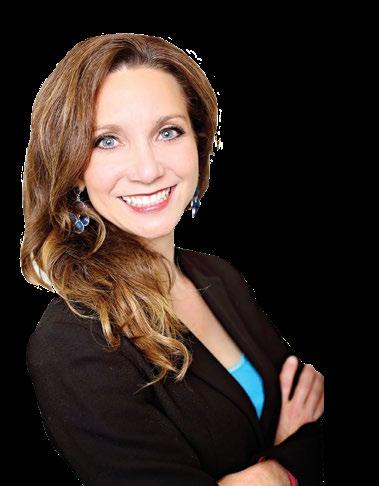
30 www.sghealthandwellnessmagazine.com
JESSICA ELGIN REALTOR®
Get Back to It
By Jay Bartlett

I sit writing this article in mid-July, when temperatures are hovering in the triple digits, and my assumption is that the heat will last for a while. It’s the type of weather that prompts many people to hang up their bikes in the garage and put their helmets and shoes in the closet to gather dust for a month or two until the meteorological fever breaks. So, if you have forgotten my written advice on how to ride through the summer and opted for time off, being that this is the September/October issue, it’s time to get back to it.






Anytime you take time off the bike, even if you stayed active during your offseason, it will take some work to get back into cycling shape. I’m assuming you are very stoked to get that sweet old feeling of whooshing through some twisty singletrack, hearing the tires bite and the freehub buzz. Ahhh, that’s the stuff. Fun, right? And that’s the get-back-on-your-bike training tip for the day: make your rides fun!
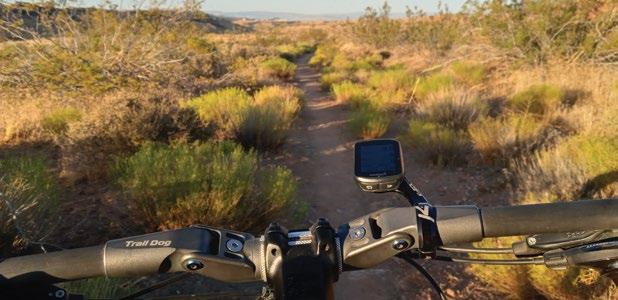
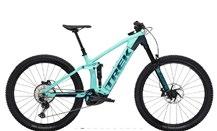
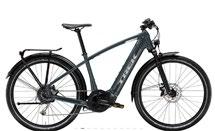



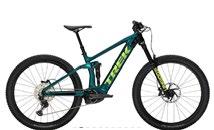






You don’t need to crush your fastest time on a trail your first ride out, and why try? Just to be disappointed? Look, we’ve already established that you spent the last two (three?) months sitting on the couch, spilling mustard from your hotdog down the front of your shirt. The fastest time is not going to happen! Sure, your brain thinks you can still ride just like you did three (four?) months ago, but your legs, back, shoulders, and butt are going to have different ideas after the first few miles. Do you know what can happen instead of your fastest time? Your funnest time on that trail.
Yup, your brain remembers what a blast you had the last time you rode Gooseberry Mesa, but your brain needs to be reminded of the full body workout that it is to get up and over those pesky, punchy, steep chunks of rock that you ride up and down all day on those trails. And since you haven’t ridden since early spring (late winter?), it’s best to save that one for a few rides into your comeback. Choose some happy places to pedal. Choose a trail system with alternate routes so you can tailor the length of your ride depending on how you’re feeling, but don’t give in too soon. There will be some “discomfort.” All the couch time and hotdogs are going to make the legs feel heavy for a while, but by pushing harder a little at a time, you’ll improve your fitness, and that relates directly to having more fun!
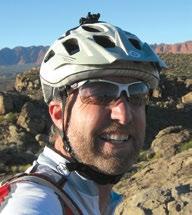
Bring a friend. Your buddy over there with the matching mustard stains on his shirt could probably use a ride as well. Misery may love company (and you may feel a little miserable on the big climbs; that’ll pass), but you know who else loves company? That’s right, fun! You can whoop and holler about the way your bike just soaked up the traction of that sweetly built berm when you’re riding alone, but it gets even more fun when your buddy adds his two-hoots-worth after railing that berm just behind you. You can also commiserate about how tough the last climb was, but that’s beside the point.
So, dust off your bike that’s been hanging in your garage for months (years?), air up your tires, lube your chain, and head out for some riding. Your brain definitely remembers the fun of leaning hard into a corner or skipping across a rock garden at speed or topping out a climb with enough steam to click up a couple of gears and accelerate over the summit and down the other side. Having fun—it’s time to get back to it.
St. George Health & Wellness Magazine | September/October 2023 31 THE BEST BIKE RIDING IN ST. GEORGE BEGINS WITH UNLIMITED CHOICES 90 S 100 E St. George, UT 84770 • 435-673-4492 • BicyclesUnlimited.com OVER 75 E-BIKES IN STOCK & READY TO GO
About the Author Mountain bike veteran, amateur filmmaker, and lover of long rides, Jay Bartlett has been riding trails in Southern Utah for over thirty years. Jay has over a decade of experience as a bike mechanic at St. George’s oldest bike shop, Bicycles Unlimited.
Take the Jump
By Becky Hurd
Jordan “Jordy” Scott began competing in BMX races early in her childhood and was sponsored to race by the time she was fifteen years old. Unfortunately, a brain injury in 2016 put a halt to her career in BMX riding. Her passion undeterred, she switched to mountain biking and was soon racing professionally again. Her career has taken her to over ten different countries around the world. “I’ve been able to travel more than most people ever do and to experience different cultures,” said Jordy.
Mentor a Child
Jordy’s love of riding and racing will continue as long as she’s able, but she recognizes she wants to do more for herself and others. She currently attends Utah Tech University in St. George, Utah, and is pursuing her bachelor’s degree in biomedicine. It was in one of her college chemistry classes that she first heard about the Big Brothers Big Sisters program. “I needed community service hours for my future master’s program,” she said. “And I have always enjoyed working with kids, especially learning to understand their perspective on things. I thought it would be fun to be a positive influence in a child’s life, so I applied.”

Knowing she was committing to be a mentor for at least one year, Jordy applied to the program and within a few weeks, was matched with Sydney*, an adventurous girl from a family of seven. Sydney’s twin brother was also matched with a mentor through Big Brothers Big Sisters of Utah. “It makes a difference knowing that someone genuinely cares about them besides their mom,” said Claire, Sydney’s mother.
Jordy knew she would be matched with a child ranging in age from six to seventeen years old and was pleasantly surprised to be matched with a younger Little Sister. “She’s similar to me as a kid—a tomboy,” explained Jordy. “I see myself in her. She has some of the same struggles with friends that I remember having myself. She’s super fun, wants to try new things, and asks good questions. Her perspective is cool.”
Jordy and Sydney have been matched for fourteen months and meet two to four times each month. They’ve shared a long list of activities together: baking, painting pottery, playing video games, visiting museums, and of course, riding bikes at the skate park and learning tricks.
Claire has seen an obvious change in her children since they began the program almost a year ago. “Having another adult listening to Syndey talk has made a huge difference,” she said. “I don’t get calls from her teacher about her fighting with other students anymore. This match has mellowed her out.”
Sydney’s father passed away six years ago, devastating the family. “We have a lot more happy moments than we did before,” said Claire. “Big Brothers Big Sisters has been the best thing that has happened to us since my husband died.”

About the Author
Becky has been the enrollment and recruitment coordinator with Big Brothers Big Sisters of Southern Utah since 2021. She earned her bachelor’s degree in sociology from Southern Utah University. Prior to working for a nonprofit organization, she worked with adults with disabilities, in child welfare, and in residential treatment facilities. She lives with her three children in Washington, Utah.

Big Brothers Big Sisters has programs in all fifty U.S. states and twelve different countries. In giving advice about volunteering, Jordy said, “If you think you might not have time to mentor a child, think again; the program is actually really flexible. I feel super busy, but I am still able to meet up with my Little more than other matches do. I look forward to it, and it gives me a break from real life. Don’t think too hard. Make sure you have the time and that you’re ready to support your Little. The rest works itself out. Anyone willing to support them will be great.”
To apply to be a Big in one of the Big Brothers Big Sisters programs, visit us online or give us a call at www.bbbsu.org or 435-986-9776.

32 www.sghealthandwellnessmagazine.com


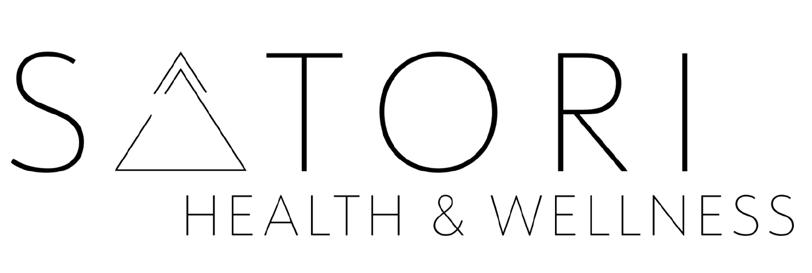

St. George Health & Wellness Magazine | September/October 2023 33 OSTEOSTRONG Red Rock | 1315 S 400 E #B1 435.767.0274 | redrock@osteostrong.me Scan our QR code to book a free session today! OSTEOSTRONG is a Once-A-Week, Natural, Non-Pharmaceutical, Skeletal Strengthening System that can help you. At OsteoStrong, “could” becomes “can.” What could you do if you had stronger bones, stronger muscles, better balance, less joint and back pain, and increased agility? Satori is Different. Schedule your free consultation today theketamineclinic.com 435-669-4403
Believe in the Magic of Christmas
Jubilee of Trees to Celebrate Its Forty-Year Anniversary
November 19–21 at the Dixie Convention Center

34 www.sghealthandwellnessmagazine.com
It’s the forty-year anniversary of the magnificent Jubilee of Trees, which raises funding for critically needed services for patients and family members at Intermountain St. George Regional Hospital.
This year, all dollars raised at the November 19–21 holiday event will support the expansion and enhancement of surgical services, filling a growing need for community members throughout the St. George region.
Jubilee of Trees is made possible by community volunteers from Utah, Arizona, and Nevada who come together to share their time, creativity, and talent to create a magical holiday experience.
“We are grateful for the generations of community members supporting Jubilee of Trees,” said Loriana De Crescenzo, executive director of Intermountain Foundation at St. George Regional Hospital. “We invite them—as well as community members wanting to volunteer or attend for the first time—to ‘Believe in the Magic of Christmas’ and join us in creating the most beautiful event yet.”
The Jubilee will showcase spectacular, whimsical, and awe-inspiring Christmas trees and wreaths created by local volunteers. It is brought to life by a dedicated local volunteer Jubilee of Trees board, who enlist the time and talents of families, organizations, and businesses throughout Utah and neighboring states.
Each year, the most urgent community needs are assessed and determined by hospital leadership in order to choose a cause area for the Jubilee of Trees. Thanks to the generosity of those who participate in the event, St. George Regional can better meet the critical needs of the growing population in the region, which features the highest percentage
of seniors in Utah and which recently saw the largest one-month growth in the entire country.

The 2023 Jubilee of Trees will support essential work to increase community access to surgical services in the St. George area and upgrade ever-changing technology in order to have the very best locally, providing even more precision, better outcomes, and shorter healing times.
Jubilee of Trees will be held Sunday, November 19, through Tuesday, November 21, at the Dixie Convention Center in St. George, Utah.
Tickets go on sale November 1. Information about the event is available at https://stgeorgeregional.org/jubileeoftrees.

St. George Health & Wellness Magazine | September/October 2023 35 Sunday, November 19 through Tuesday, November 22 Dixie Convention Center 1835 Convention Center Drive, St. George, Utah stgeorgeregional.org/jubileeoftrees


36 www.sghealthandwellnessmagazine.com
Some of the most common symptoms of sacroiliac joint pain include lower back pain, hip pain, and pain in the buttocks. Individuals may also experience stiffness, weakness, and even numbness in the legs. These symptoms can be caused by a variety of factors, including arthritis and recent/former injuries.
What is the sacroiliac joint?
The sacroiliac joint connects the spine to the pelvis on each side of the human body. It’s where the sacrum—the triangular bone at the base of the spine—connects to the ilium, one of the large bones that is part of the pelvis.
Almost all of the weight and pressure from the upper body transmits through the sacroiliac joint, and it’s important for proper movement and stability of the pelvis when walking, running, and even standing. If the sacroiliac joint becomes irritated or inflamed, it can cause serious pain in the lower back, buttocks, and legs, making it difficult to perform everyday tasks and activities. If the pain persists, it can become permanent and debilitating.
What causes sacroiliac
joint pain?
Permanent sacroiliac joint pain can be caused by numerous factors ranging from a recent or past traumatic fall or accident to age-related joint degeneration. Pain may also be caused by pregnancy and childbirth or by previous surgery.

Sacroiliac joint pain can be difficult to pinpoint. It mimics and is similar to pain that radiates from the lower back. Therefore, it’s important to consult with a qualified physician, like those at Southwest Spine & Pain Center, who can accurately diagnose both low back and sacroiliac joint pain.
How is sacroiliac joint pain diagnosed?

Accurately diagnosing the sacroiliac joint as a source of pain relies upon an extensive range of tests. A series of physical manipulations specifically designed to stress the sacroiliac joint are performed. If pain is provoked by some of these tests, then this is a good indication it is originating in the sacroiliac joint.
Diagnostic and therapeutic injections into the sacroiliac joint are also performed to accurately diagnose sacroiliac joint pain.
Sacroiliac Joint Pain and Innovative Treatments
These injections place a pain-relieving medicine into the joint. If the pain is significantly relieved by the medicine, this is another good indicator the pain is indeed originating from the sacroiliac joint.
Dr. Jon Obray, Dr. Rick Obray, Dr. Derek Frieden, Dr. Bryt Christensen, and Dr. Casey Muir all perform these tests and injections in their facility at Southwest Spine & Pain Center, located at 2891 E. Mall Drive in St. George, Utah.
Once it’s suspected and/or confirmed the source of pain is indeed the sacroiliac joint, a specialist at Southwest Spine & Pain Center will prescribe non-operative treatment called conservative care. Conservative care ranges from physical therapy to lifestyle changes including exercise and diet. Other forms of conservative care may include modifying physical activity, weight loss, medications, and bracing.
People do improve and get better from conservative care, but if it doesn’t reduce or eliminate the sacroiliac joint pain and improve function, it’s time to consider the next steps, one of which is surgery to fuse the sacroiliac joint.
What is a sacroiliac joint fusion?
A sacroiliac joint fusion is where a titanium implant is used to temporarily connect the ilium to the sacrum across the sacroiliac joint itself. Eventually, that connection becomes permanent with new bone growing across the joint, through and around the implant, to permanently fuse the joint and reduce or eliminate the sacroiliac joint pain.
By Ryan LeCheminant
The physicians at Southwest Spine & Pain Center have adopted a new surgical technique and approach to sacroiliac joint fusion called the Catamaran SI Joint Fusion System. The Catamaran is implanted into the sacroiliac joint and connects the ilium to the sacrum.
“As a group, we have started using the Catamaran technology because of its safety and effectiveness over other options if a patient needs surgery,” said Dr. Jon Obray, a physician with Southwest Spine & Pain Center. “The Catamaran surgical approach is safer because of how it is implanted into the sacroiliac joint, approaching away from nerves and blood vessels. It’s also a single, robust design requiring just one implant. With other technology, we had to use two or more implants.”
Obray added that most patients experience pain relief within four to six weeks, sometimes sooner. Like any surgery, there are risks to consider and clinical outcomes vary depending on age and health, among other variables. To schedule an appointment and discuss possible treatment, please contact Southwest Spine & Pain Center at 435-656-2424 or visit SouthwestSpineandPain.com.
St. George Health & Wellness Magazine | September/October 2023 37
Intermittent Fasting: Good or Bad?
By Dr. Coleen Andruss, Healthy Lifestyles

Research has shown that our bodies have evolved to the point where we can go without food for many hours, even several days or longer. Before human beings learned to farm, they learned to survive by becoming hunters and gatherers; there was no other choice. Humans really can survive for long periods of time without eating.
The problem now is that our access to food has become easy, and we, as Americans, have become lazy when compared to our ancestors. We have the luxury of television, computers, grocery stores, and automobiles, but these are just a few of the many conveniences we enjoy. We eat foods that are higher in calories, and we burn fewer calories because of our lifestyle. It only makes sense that we would become obese and that the incidences of obesity-related conditions would rise. Can going prolonged periods of time without eating help these problems?
In the past, eating six small meals a day to increase metabolism was recommended. Remember that metabolism is calorie burning and not really fat burning. To burn fat, we must force the body to use what we have stored and that means not supplying the fuel from an external source.
This is the concept of intermittent fasting (IF), also referred to as metabolic switching. Research demonstrates that once the body exhausts its sugar stores, it starts burning fat. But remember, this is not “cookie-cutter science.” Not every plan works for every individual, and there are many plans that can be recommended.
Alternate Day Fasting requires fasting every other day. Modified Alternate Day Fasting requires you to eat 25 percent of the usual intake every other day. Periodic Fasting requires you to limit food to 500 calories a day at least two days per week (5:2 approach). Time Restricted Eating limits the daily eating window. The most common of this type of plan restricts you to either a six-hour window or an eight-hour window, skipping at least one meal of the day and not snacking at all. There is also Prolonged Fasting, which involves as long as twenty-four, thirty-six, forty-eight, and even seventytwo hours of fasting. In most cases, prolonged fasting burns fat, but in some individuals, it can actually lead to fat storage in response to starvation

When in the fasting time period, water and non-carbonated, zero-calorie beverages, such as black coffee and tea, are allowed. When eating, you must eat healthy food. Protein is critical for maintaining muscle mass. Vegetables are critical for fiber, nutrients, and vitamins. Good fats are important for the nervous system and for satiety. Even some high fiber, unprocessed complex carbohydrates can be eaten. Just don’t go crazy!
Negative effects can occur. Some of the side effects people experience include lethargy, constipation, nausea, lightheadedness, crankiness, and headaches. A 2021 Journal of the American Medical Association study found a negative correlation between hunger and mood. Feeling brain fog is a sign that you’re not eating the right foods during non-fasting hours or that fasting isn’t right or safe for you. Sometimes, overindulging on non-fasting days occurs because of the inherent nature of the reward system and because it can interfere with the normal circadian rhythm. According to The National Eating Disorders Association, restrictive diets can sometimes lead to orthorexia, an eating disorder that creates an abnormal relationship with food where one spends an excessive amount of time thinking about the quality or quantity of food. The Journal of Obesity has documented that women’s menstrual cycles can slow down or even stop
About the Author
Dr. Coleen Andruss practiced as an internist for ten years and has specialized in weight management for twentynine years. She and her staff have personally experienced weight management issues and have a compassionate understanding of patients in the Healthy Lifestyles program. Dr. Andruss’s internal medicine background helps her to see underlying medical problems when formulating individual plans that work.
completely during intermittent fasting, and for some, there can also be a significant amount of hair loss.
The elderly need to be particularly cautious with intermittent fasting because it can affect the immune system, energy level, bones, and muscle mass. People with certain medical conditions and on certain medications also need to be cautious. Diabetics on certain medications should not go too long without food to prevent hypoglycemia. Some medications require food for absorption and some require food
38 www.sghealthandwellnessmagazine.com
to prevent nausea. Depending on medical conditions, care should be taken that fasting does not mess with electrolytes and cause low sodium, potassium, and magnesium levels. People who should avoid all kinds of intermittent fasting are children and teens under age eighteen, women who are breastfeeding or pregnant, people with type I diabetes, and people with eating disorders.
Positive effects, however, can outweigh the negative. Fat burning is the most common benefit. Research has shown
that intermittent fasting of any kind can boost memory and mental focus, improve blood pressure and resting heart rate, and increase overall physical endurance. But it is not clear whether these are a benefit of the fasting itself or a benefit of fat loss. According to a 2022 study in the Journal of Physiology and Biochemistry, intermittent fasting lowered fasting glucose levels, leptin, and fasting insulin levels, all of which are necessary for fat loss. In some cases, intermittent fasters can reach autophagy, a cleanse at the cellular level where unnecessary

or dysfunctional components of the cell are degraded and recycled. This is how fasting can help chronic disease conditions and inflammation.
Diet trends have come and gone, and there is lots of confusing information available for people. Intermittent fasting is not really a diet but a way of eating, both for health benefits and for fat loss. Weigh the risks and benefits and ask for professional help when deciding whether intermittent fasting is right for you!
St. George Health & Wellness Magazine | September/October 2023 39
Tips for Making Your Home Healthy for Your Pets
We all spend time trying to keep up with the pet hair and other pet mishaps in our homes. Why? Because we want to live in a clean house! However, we sometimes overlook the fact that keeping a home clean for our pets is just as important for their health and quality of life.

Grooming
The most important thing we can do to keep our homes healthy for our pets is to brush their coats daily. This recommendation applies just as much to cats as it does to dogs. Grooming is an important part of an animal’s life. We see them grooming, often several times a day, but we forget to help them with that task. Start when they are young, and they will learn to look forward to that daily brushing. Keep your pet’s nails trimmed, too. Nails can carry debris on or under the surface.
By Anita DeLelles, LMT
For both dogs and cats, wipe their paws when they return from a walk or stroll in the garden. This reduces the danger of bringing contaminants into the home that could infect other older or sick animals. Special pet wipes are available to make this task quick and less stressful for both pets and humans alike. By using these daily hands-on approaches with your pet, you’ll very quickly know if something is amiss: a new bump, scratch, allergy, or illness.
Environment
Does your pet have a favorite place to sleep or nap? Do you find that your pet loves to lay on freshly laundered items? Well, of course! Who doesn’t love that clean fresh smell. Place a pet bed, towel, or sheet on that napping spot. Then, when it’s time to clean up, shake it out and toss it in the wash. Having a place that pets can claim as their own and keeping it clean for them
40 www.sghealthandwellnessmagazine.com
cuts down on having to fight hair build up on couches, carpets, and chairs.
Let’s talk about cat trees—those old carpet covered trees that look like they have been attacked by a tiger and that harbor germs, bacteria, and who knows what! Time to change to a new, easy-to-clean cat tree, like a modern CurvyNest or a safe modular cat wall. They are designed for easy cleaning and to be aesthetically pleasing in your home.
Food and Water
If you free-feed (leave food out all day), stop! Giving pets access to unlimited food all day is never a good idea for so many reasons, the least of which are the mess and the possible bugs and rodents. Food areas need to be wiped and cleaned after each feeding, enabling you to maintain a healthy eating environment for your pet and reduce the likelihood of bugs, flies, or even illness. Food that sits out all day can spoil or become contaminated. Most importantly, by feeding at specific mealtimes, you will know if something is not right with your pet.
Bowl choice is also a factor to consider. Food-grade stainless steel bowls are your best choice (304 or 316). Ceramic bowls may contain lead paint. They can also flake, crack, or chip, leaving food particles to build up even after washing. Plastic bowls can break down, allowing plastic to contaminate the food.
Fresh clean water is a must. A water fountain with a filter is the best option for all pets. The moving water is less likely to

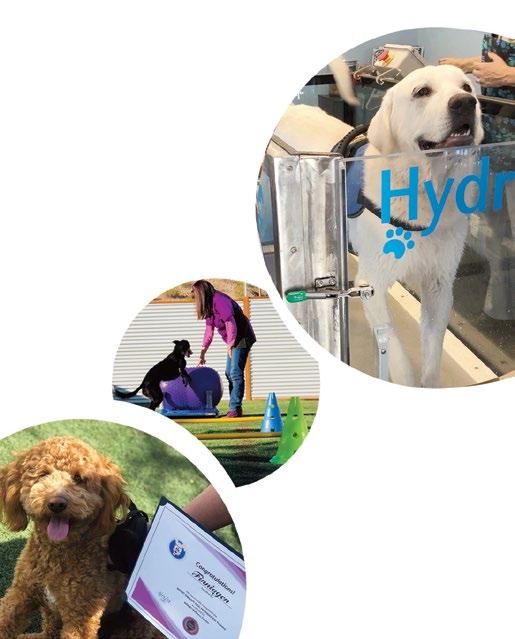
become contaminated, and the water flowing through the filter removes any particles that fall in the water. Regular cleaning is still necessary to ensure that there is no excessive scale or slime buildup in the bowl. If a fountain is not an option, then bowls must be cleaned thoroughly at least once a day, and water should be changed once or more a day.
Keeping our homes clean for our pets may not be our main objective, but when you consider the health benefits, it matters greatly. Cleanliness becomes just as important as the food you select for your pets or the exercise your pets receive. A clean home for pets reduces allergies, illness, stress, and anxiety for you and your pets!

About the Author
Anita DeLelles, LMT, is a certified equine and small animal acupressure practitioner with accreditation from the Tallgrass Animal Acupressure Institute and a member of IAAMB. Her Tallgrass training has included two consecutive summers in Bath, England, near where she lived as a child, as well as coursework in Colorado and northern California. Additionally, Anita is certified in animal massage from the Northwest School of Animal Massage as well as human massage in the state of Utah and is a graduate of UNLV. In 2013, Anita and her husband, Ron, opened WOOF! Wellness Center & Training Academy to serve pets and their health-conscious pet parents. WOOF! is dedicated to improving the quality of life for companion and competitive animals through fitness and conditioning, education, and proper nutrition. Anita shares her life with Ron and their overly-pampered cats in Santa Clara, Utah.

St. George Health & Wellness Magazine | September/October 2023 41 Join WOOF! Wellness Center & Training Academy for trainer-guided hikes. We request that dogs have completed a basic manners class or loose leash walking class to participate in the hike. Our trainer can set up a free assessment if you are not sure about your dog’s ability to join the hikes. Call 435275-4536 or visit www.woofcenter.com. 3199 Santa Clara Drive In the Historic District Open Monday - Saturday (435) 275·4536 woofcenter.com Ask us about: • Fit n’ Fun • All-Positive Training • Puppy Socials The Premiere Pet Fitness Center in St. George We offer: • AcuPressure Massage • Hydro Treadmill • Fitness & Rehabilitation • Dog Bathing & Mini-Grooms • Healthy Treats & Supplements Wellness, Training & Rehabilitation
DELICIOUS, DIFFERENT, AND FRESH ARE WHAT THEY DO
Also added to the menu as a temporary seasonal item is Elote (Mexican corn on the cob). For those who have grown up eating corn the American way with butter and salt, you’ll find this corn-onthe-cob to be so much better that it will be hard to ever go back. Each ear of corn is made the traditional way with Mexican cheese and sprinkled with red pepper—a messy and phenomenal treat for your taste buds. You might even experience what we call Elote Face!

If you are looking for a truly excellent Mexican restaurant that offers delicious menu options, great service, and excellent value, look no further! Angelica’s Mexican Grill, located at 101 East St. George Boulevard, is that one-of-a-kind taste adventure you are craving.

At Angelica’s, everything on the menu is “made with love” by owner and restaurateur Angelica Lancaster, who immigrated to the United States from Mexico over eighteen years ago. She uses her mother’s and grandmother’s recipes and inspiration to create authentic Mexico City-style street food with salsas, veggies, and meats that are prepared daily. You can taste the freshness!
Although the menu at Angelica’s is deliberately small, it is filled with everyone’s favorites: Street Tacos, Quesadillas, Burritos, Mulitas, the Angelica’s Special, and the Fajita Platter with sides that include rice, beans, avocado, sour cream, and grilled fajita veggies. You can customize your entree with your choice of meat; Angelica’s offers carne asada (seasoned and grilled chopped steak), machaca (shredded beef cooked in a red sauce), pollo asado (seasoned and grilled chicken thigh meat), carnitas (pulled and fried pork shoulder), chile verde (very spicy pulled pork stewed with grilled peppers), sweet pork (carnitas pork grilled with Angelica’s special sweet sauce and caramelized), and Vegetarian (grilled bell peppers, onions, and cabbage with seasoning).
Recently, a new menu item, Quesabirria, was permanently added. It consists of two crisp corn tortillas that are filled with cheese and shredded beef and served with a side of consommé for dipping. Angelica describes it as a cross between a taco and a quesadilla, and it is quickly becoming a customer favorite.

Diners can make their plates special by visiting Angelica’s unique salsa bar. Start with fresh pico de gallo (chopped cilantro, onions, and tomato). Then, add the crunch of fresh cut cabbage and the tang of fresh-cut lime. Finally, top it all off with Angelica’s five delicious salsas, which have earned the People’s Choice award at the Washington County Fair for the past two years. Salsas include the wimpy mild tomatobased salsa; the medium salsa spiced with roasted serrano peppers (comes with a kick, but not out the door); the hot salsa, which uses two different peppers to light up your taste buds; the verde (green) salsa, a tangy tomatillo-based salsa with medium heat (great served with pork); and the habanero marinated red onion—so hot that a little goes a long way. Add just a few onion slivers to your entree for that “wow” flavor! And since Angelica’s Mexican Grill is not like any other Mexican restaurant, here is a list of what you won’t find there: lettuce, yellow cheese, enchiladas, refried beans (they serve whole pinto beans), guacamole (they do offer half avocado), and chips. It might seem counterintuitive to have no tortilla chips on the menu, especially since Angelica’s has such an extensive salsa bar. But Angelica thinks of it this way: “In Mexico City where I grew up, when you went for street tacos, there were no chips. Chips with salsa is, I think, an American thing, and I want my restaurant to give each person the Mexico City street food experience. I promise, you will not miss the chips, and you will eat more of my delicious food instead of filling up on chips.”
When you are in the mood for something different and you are ready to have a taste experience that will keep you thinking about sweet pork street tacos for a week, head over to Angelica’s Mexican Grill. They provide indoor and patio dining and live local music on the weekends in the spring and fall.
Different, delicious, and fresh are what they do!
42 www.sghealthandwellnessmagazine.com
Left: Quesabirria, Angelica’s newest menu item.
ALLERGY RELIEF IS JUST A FEW “DROPS” AWAY!

83% PATIENTS EXPERIENCE A DRAMATIC REDUCTION IN ALLERGIES FROM:

• POLLEN, DUST, MOLD & GRASSES
• CATS & DOGS
• SHELLFISH
• GLUTEN, SOY & FRUIT
• AND HUNDREDS MORE!
WITH A 90% PATIENTS EXPERIENCE SIGNIFICANT IMPROVEMENT IN ASTHMA!
FUSION PHARMACY NOW OFFERS
CONVENIENT, COST-EFFECTIVE SUBLINGUAL IMMUNOTHERAPY WITH ZERO SHOTS!
IF YOU ARE A HEALTHCARE PROVIDER INTERESTED IN ALLERGY EASY FOR YOUR PATIENTS, CONTACT US TODAY!
St. George Health & Wellness Magazine | September/October 2023 43
MORE! Conventional Prescription Pharmacy, Specialized Compounding, and Natural Alternative Therapies www.FusionSpecialtyPharmacy.com • #FusionIsBetterMedicine ST. GEORGE Riverfront Medical Center (435) 656-2059 617 E. Riverside Dr., Suite 104 St. George, UT 84790 Fax: (435) 656-3059 Email: fp@rx-fusion.com SANTA CLARA Canyon View Dr. & Sunset Blvd. (435) 703-9680 1100 Canyon View Dr., Suite C Santa Clara, UT 84765 Fax: (855) 853-3465 Email: rx@rx-fusion.com
ALLERGY EASY! SUFFER NO
From Passion to Profession: A Utah Tech Student’s Journey to NCIS
 By Jake Harber
By Jake Harber
When most people hear “NCIS,” they usually think of the hit action drama on CBS. Some don’t realize that the NCIS, or Naval Criminal Investigative Service, is an actual federal agency specializing in investigating criminal activities involving the Navy and Marine Corps. Kylee Newsome, a recent graduate from Utah Tech University, found inspiration in the show she grew up watching with her grandpa and after years of pursuing her dream, was accepted into NCIS at the beginning of May 2023.
Knowing she wanted to do something similar to what she witnessed on the television show, Kylee began researching NCIS and found out that it wasn’t as glamorous as television made it out to be. Still, she found a deep interest in the agency and began her education by majoring in forensic biology. Kylee soon discovered she didn’t want to specialize in that particular field, so she switched her major to criminal justice with an emphasis in digital defense and security.
In addition to being involved in the Utah Tech Digital Forensic Crime Lab internship, Kylee also spent six weeks at the Amsterdam University of Applied Sciences, exploring their forensic sciences program and piloting a student exchange program between Utah Tech and the Amsterdam University of Applied Sciences. She also attended several conferences, which propelled her toward securing a job with NCIS.
After completing a six-month application process, Kylee learned that she had been accepted into NCIS, achieving her lifelong dream. Of course, one of the first people she told was her grandfather, the person who first ignited her interest in the field based on their time spent watching the NCIS show.
Kylee is the first to recognize that achieving her goal required personal determination and the help of others. “I had to put myself out there by talking to people and reaching out to find somebody who would take me to the next step,” she explained. She credits Mark Spooner, director of the Digital Forensics Crime Lab at Utah Tech University, as a big part of why she was able to do everything she did in college. “All of my teachers have been extremely helpful and very understanding,” she said. “I wouldn’t be here without them. Mark gives his students so many opportunities. He takes them to conferences around the country, and he has connections that will help them.”
The last step of Kylee’s journey began in July when she headed to Glynco, Georgia, to begin a five-month training program at the Federal Law Enforcement Training Center. Once it is completed, she’ll be off to San Diego, California, to begin her career. For more information about Utah Tech University, visit utahtech.edu. To learn more about Utah Tech’s Digital Forensics program, go to dfcl.utahtech.edu.
About the Author
Jake Harber is a full-time student at Utah Tech University. A small-town Wyoming native, he moved to St. George to pursue a bachelor’s degree in communication studies and work toward a career in public relations. He enjoys the Southern Utah climate and all the outdoor adventures this area has to offer.

For more information about Utah Tech University, please visit utahtech.edu.

44 www.sghealthandwellnessmagazine.com


St. George Health & Wellness Magazine | September/October 2023 45 utahtech.edu
Oh, How Time Flies
By Lyman Hafen
Twenty-five years ago, on the eve of my twenty-fifth high school reunion, I took stock of what I’d learned at Dixie High School between 1970 and 1973. At the time, I’d not heard Bruce Springsteen sing the words, “We learned more from a threeminute record than we ever learned in school.” I don’t agree with that line, but sometimes I wonder when I think of those sleepless nights I endured before an algebra test. In the fifty years since I walked out the doors of Dixie High, I’ve never once found myself teetering on the edge of doom because I could not solve an algebraic equation.


There were a lot of things I didn’t know when I graduated from Dixie High a half-century ago. I did not know that the moment I stepped out of the simple, secure world within those walls I would stumble headlong into the real world, a world spinning so fast and out of control that even the great Class of ‘73 could not save it. I’d grown up in black and white, but it was a full-color world that awaited me—with all its shades of gray.
I was born on the crest of the Baby Boom in the pivotal year 1955—the year that gave us Disneyland and Elvis. My generation was not expected to amount to much. After all, we were literally raised on rock and roll.
We hovered around our TV sets and watched in rapt attention—our Greatest Generation parents cringing in disbelief— as the Beatles stormed the Ed Sullivan Show. And it was the national common denominator of television that revealed to us all, simultaneously, the tragedy of John Kennedy’s assassination in Dallas, the audacity of hippies taking over Haight Ashbury in San Francisco, and the horror of choppers flapping heavily over the jungles of VietNam.
And yet, for a generation raised on sugar frosted flakes, miniskirts, and the Fab Four, we didn’t turn out so bad—not bad at all for a shaggy-haired bunch who lunched on barbecue flavored potato chips and Hires root beer at Judd’s Store, who bear-hugged in the Woodward Gym as Tommy James and the Shondells sang “Crimson and Clover”–over and over, and Paul McCartney cried “Nah nah nah nahnah-nah nah” into the wee hours of the night. We didn’t turn out so bad for a generation that wandered home every day
46 www.sghealthandwellnessmagazine.com
Left: From left to right: Donna (Leavitt) Gentry, Class Representative; Debbie (Houston) Ence, Amusements; Fran (Leany) Hannig, Amusements; Kevin Ence, President; Loy Ann (McArthur) McLendon, Secretary; Janet (Wasden) Fayard, Amusements.
Photo next page, top right: Allen Feller, 1973 Studentbody President
after school to witness Walter Cronkite’s Vietnam death count on TV—not bad at all for a class that reached puberty at the height of the sexual revolution and witnessed the word “Watergate” take on a new meaning in the English language, a class that finished high school the same year Richard Nixon was finished as president.
Johnny Nash had a hit song that year called “I Can See Clearly Now.” I thought I saw everything clearly then. I had no concerns greater than lunch money and who to ask to the dance on Saturday night. Seals and Crofts had a hit song, too. It was called “We May Never Pass This Way Again.”
They were right.
From my perch twenty-five years ago, I looked back and figured I’d paid sufficient dues to finally see it all clearly. I had high school graduates of my own by then. My two oldest sons had learned volumes more in high school than I ever dreamed of learning in my entire life. My oldest son had read most of the classics, a task I’m still chipping away at. He was already on a track that would lead to graduate school in Germany, where he lives today and teaches those classics at the International School in Bonn. My second son was already programming computers and on a track that would lead him to a doctorate in statistics at Purdue and a career as a world traveling consultant in data analysis. My other four children would soon follow their own passions into law school, music, digital engineering, and film restoration.
Now, another twenty-five years on, the first three of my eighteen grandchildren will graduate from high school themselves next year. Each of them has traveled to and seen more of the world than I could have ever imagined seeing. Each of them carries in a small, flat, rectangular device tucked in their pocket more information than I could have ever accessed in all the libraries that existed on earth when I was in high school. There is no limit to what they might do or how far they might go as they follow their own passions. What they don’t know yet is how much they don’t know. They have access to all worldly knowledge; what they don’t have is what you learn after you walk out of those high school doors the last time.
Here are some of the things I wrote down twenty-five years ago— things I’d learned after twenty-five years out of high school:
• The length of a year reduces as you grow older. By the time you are forty, a year can pass without you knowing it.
• My parents really were right—every time.
• There are heroes whose names you never hear.
• Stories are all that hold us together—stories and compassion.
• Don’t forget to stop and smell the flowers.
• You’ll get over it.
• Hard times come and hard times go… and hard times come and hard times go…
• These are the good old days.
• The person who speaks the least is the person you want to listen to most.
• It’s never too late to start down a new road.
• Relationships are all you can really take with you.
• Work beats luck any day.
• It’s one thing to be smart but quite another to be able to think.
• It’s one thing to have an impressive resume but quite another to be able to get things done.
• Ten minutes visiting a rest home is better than ten hours in front of a TV.
• Next week, no one will remember what the score of the game was, but everyone will remember what you yelled at the ump.
• One live smile from one live person is worth every television show ever produced.
• Your children will remember what you did long after they forget what you said.
• These are the good old days.
• If you want to be somebody, be yourself.
• If you want to find yourself, get lost.
• Whether you cast good or bad upon the water, the same will come back to you multiplied.
• Never pass a neighborhood lemonade stand without stopping and buying some.
• And did I mention…these are the good old days.
• Life is not fair. It takes eternity for things to even out.
• If you want to see eternity, look into your child’s eyes.
The great Dixie High School Class of ‘73 will celebrate its fiftieth reunion in September. As I take stock of what I wrote twenty-five years ago, there is nothing I would change. Just one more thing I would add:

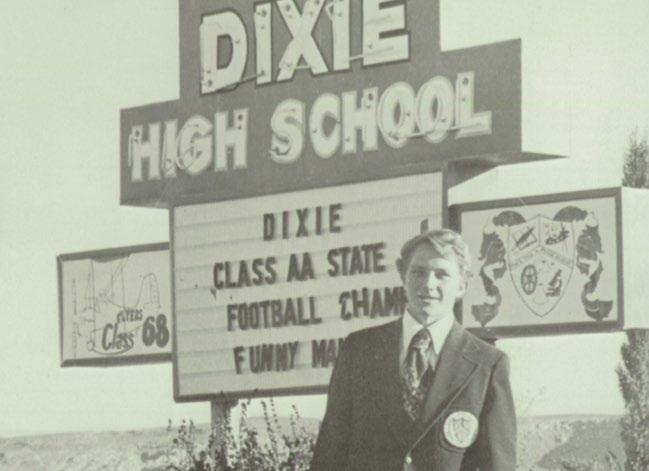

Time flies on wings of lightning. We cannot call it back.
About the Author Lyman is the author of a dozen books intent on connecting landscape and story in the American Southwest. He was founding director of the Zion Forever Project and was president of the national Public Lands Alliance. He’s been writing and publishing for more than 40 years, with several hundred magazine articles in publications ranging from Western Horseman to Northern Lights, and was the founding editor of St. George Magazine in 1983. He’s been recognized on several occasions with literary awards from the Utah Arts Council, and won the Wrangler Award from the National Cowboy and Western Heritage Museum. He lives in Santa Clara, Utah, with his wife Debbie, and together they have 6 children and 18 grandchildren.
St. George Health & Wellness Magazine | September/October 2023 47
Healthy Risk Taking Helps Young People
By Rob Henderson

Youth mental illness, like anxiety, depression, and suicide, are on the rise in startling numbers—so much so that many professionals are saying we are in a “youth mental health crisis.” As a therapist with a practice that serves mostly youth, I’m not only working with this firsthand but I’m also watching my own children, their friends, and many of our immediate and local acquaintances struggle in various degrees with mental health.
Mental health treatments and therapies can be complex and often require multidimensional resources and support. However, one direct and evidence-based prevention and treatment for youth mental illness is cultivating strong self-efficacy, which is when a person has a healthy belief in their own ability to navigate life’s struggles and do hard things.


Self-efficacy can be built in youth by challenging them to take healthy risks. When researchers say “healthy risk-taking,” they’re not saying you need to go cliff jumping or skydiving (though the former happens to be one of our family faves, and...I may or may not have looked into the latter for a family outing). To build self-efficacy, the goal is to draw people out of their comfort zones and into growth zones but not push so hard that people enter a panic zone. We want that growth zone sweet spot where vulnerability, novelty, and even discomfort are present. It’s here—while marinating in feelings of awkwardness but then navigating out of those feelings—where the awesome skill of resilience (another way of looking at self-efficacy) starts to develop. Resilience is a key ingredient for mental wellness and a buffer to mental illness.
Self-efficacy is stymied when adults too often swoop in and try to fix youths’ problems. There is a misconception in some circles that risk-taking behavior in youth is inappropriate and should be avoided. But youth development research debunks this belief. In fact, best practices now call for adults to not just NOT extinguish risk-taking behaviors (yeah, that was a double negative), but to actually cultivate, channel, and even praise them. The research goes on to point out that one of the best ways to accomplish this is for adults to model healthy risk-taking behaviors with youth. And lucky for us, “healthy risk” comes in all shapes and sizes. Here are some ideas: speaking in public, performing in a talent show or play, running or campaigning for a voted position, trying a new exotic dish, watching a scary movie together, competing in a sport or activity, disassembling something complex and then trying to put it back together (I think I’ll volunteer something of my wife’s for that one), riding a rollercoaster, jumping or doing a trick off the high-dive, going for a difficult hike, backpacking, and the list goes on...
In short, one of the best protective factors that we can give our youth against mental illness is to work at not being so protective...to actually ground our hovercopters and push the snooze on our inner mama bear! This is a unique paradox but one that is necessary for our youth and their health and wellness.
About the Author
Rob Henderson is a dually licensed addiction counselor and recreation therapist (see AREtherapy.com) and is also an experiential trainer for behavioral health professionals (see RITEtrainings.org). Rob is married with a ginormous family that loves to adventure together (follow this wild bunch and they’re adventures on social media @ Dareful Parenting).
ADVANCEMENTS IN DENTAL MEDICINE
By Dr. William Plumb, DDS, Plumb Dental
The other day, I was finishing up a root canal. The procedure had only taken a few minutes, and when I sat the patient up, she asked, “Is that it?”
I thought back to my dental school days when I had performed the procedure for the first time. Root canal therapy is needed when the inside of the tooth becomes infected and the nerve dies. Often, the infection spreads to the bone, causing an abscess which can result in debilitating pain. The clinic for endodontics (the root canal dental specialty) was on the third floor, and I remember having to walk up and down the stairs carrying all my gear and equipment. The instrument list for this treatment was extensive, and it was easy to forget or misplace something, necessitating another trip down the stairs. The procedural steps were also complex. Great care and often a lot of time were needed to navigate and clean the canals. Breaking an instrument inside the canal was a real risk. Radiographs were often used during the procedure to monitor progress, and I would have to sit the patient up and walk them over to the X-ray room with their mouths propped open. The patient stayed there while I developed the film, hoping that it would show me what I needed to see.
Completing the procedure involved bunsen burners and hot pokers.The whole process was pretty archaic. Archaeologists have uncovered Egyptian mummies that show evidence of root canals being performed thousands of years ago. It probably wasn’t terribly different from how we did them just twenty years ago!
I love how rapidly the dental industry is advancing. The anesthetics are more effective, so patients feel less discomfort. Radiographs are digital, using a fraction of the radiation and giving us instant feedback. Dentists now also have access to 3D radiographic imaging. This allows us to determine depths as well as heights and widths without the distortion of a traditional 2D X-ray. The instruments are safer, more efficient, and more effective.

In the case of endodontics, the files that I use now to clean the inside of teeth are so much sharper and more flexible than those I was using even ten years ago; I’m able to do the work in much less time and minimize risks for my patients. Implants integrate more effectively into bone, and it seems like there are daily improvements made to the implant-prosthesis interface. The ceramics used in cosmetic dentistry have become more lifelike and beautiful without sacrificing strength, and crowns can be delivered in a single appointment.
As our equipment and materials become more advanced, our techniques improve as well. Procedures are more predictable and long-lasting and are performed faster and safer. This is good news for me as a dentist (I like things to be simple, and you wouldn’t believe how an open flame can heat up an operatory!), but it’s easy to see how less time in the chair along with treatment that is safer and more predictable are benefits to patients as well.
I come across so many people who put off dental treatment for a number of reasons, but few grasp what a critical role oral health plays in their overall general health. Hopefully. I’ve been able to alleviate some concerns and provide motivation to seek care that will improve the quality of your life.
About the Author
Dr William Plumb graduated from the State University of New York School of Dentistry in 2006. He opened Plumb Dental in St George, Utah, in 2009. He has received extensive continuing education in cosmetic dentistry as well as oral surgery and implantology. Dr. Plumb loves living in southern Utah with his wife Kari and their four children.

50 www.sghealthandwellnessmagazine.com




52 www.sghealthandwellnessmagazine.com NEW APP Your #1 Source for Local News DOWNLOAD scan to
Non-Sugar Substitutes
By Scott Allen, MD, Medical Director, Satori Health and Wellness


In 1897, a chemical researcher at Johns Hopkins University forgot to wash his hands after a day in the lab. He tasted something sweet on his fingers and retraced his steps to find the culprit: benzoic sulfamide, also known as saccharin (the Latin word for sugar). Thus began humanity’s love affair with artificial sweeteners.
In another example of poor hand hygiene leading to a scientific breakthrough, the sweetness of cyclamate was discovered by a University of Illinois grad student on his smoke break who had neglected to wash up after an experiment. Cyclamate is thirty to fifty times sweeter than sugar and was commonly known as the pink-packeted Sweet ‘n Low—until cyclamate was proven to cause bladder cancer in rats. Bummer, to be sure. The FDA banned cyclamate, and it was replaced by saccharin in Sweet ‘n Low.
Though it wasn’t available commercially until 1981, aspartame found its way into the American diet when another research chemist licked his unwashed fingers in 1965. It reigned supreme amongst sugar substitutes until sucralose (Splenda) emerged in the 1990s. Sucralose is 600 times sweeter than sugar and is made by adding a chlorine molecule to sucrose.
Although they don’t add calories to food, all is not candy and rainbows in the world of artificial sweeteners. For years, aspartame has been suspected to cause adverse health outcomes. This year, researchers reported in the Journal of Toxicology and Environmental Health that sucralose may damage DNA.
In a model of the human gut, sucralose was found to induce gene expression that led to inflammation, oxidative stress, and cancer. It may lead to increased permeability in the human intestine (also known as “leaky gut”). The implications of these findings aren’t entirely clear, but it may be time for us to rethink our love affair with sweeteners.
Most people consume artificial sweeteners for their calorielowering effects, especially in an era when 60 to 70 percent of American adults are overweight or obese. However, replacing sugar with artificial sweetener is unlikely to result in weight loss. In May 2023, Francesco Branca, Director of Nutrition and Food Safety at the World Health Organization issued the following statement:

“Replacing free sugars with NSS (nonsugar substitutes) does not help with weight control in the long term. People need to consider other ways to reduce free sugars intake, such as consuming food with naturally occurring sugars, like fruit, or unsweetened food and beverages. NSS are not essential dietary factors and have no nutritional value. People should reduce the sweetness of the diet altogether, starting early in life, to improve their health.”
It’s clear that excess calories lead to adverse health outcomes, such as diabetes and heart disease. As much as we love our Diet Coke, though, it may be time to replace all sweeteners with healthy, life-sustaining, high-quality H2O. Bobby Boucher will be proud.
About the Author
Dr. Scott Allen is a St. George-raised, board-certified anesthesiologist. He has specialty training in transplant anesthesiology and currently practices with Mountain West Anesthesiology at St. George Regional Hospital. He is also the medical director of Satori Health, an integrated ketamine clinic (www.theketamineclinic.com). Dr. Allen is the current president of the Washington County Medical Association. With his deep roots in Utah, he has a special passion for improving the mental healthcare of his friends and neighbors in the community. Dr, Allen enjoys outdoor pursuits with his family and communing with nature. He’s doing his best to stay grounded in the moment!
George Health & Wellness Magazine | September/October 2023 53
St.
As Soon As…
By Matt Eschler, PhD, LMFT
I get to be on the front line with people that want to see changes happen in their relationships and in themselves. So often at the very beginning of the change process, the first barrier that slows down the desired change is the “as soon as” speed bump. Whenever you say, “As soon as (fill in the blank), I will change,” you know that you aren’t really ready to change. As soon as my wife stops yelling at me, I’ll quit drinking. As soon as I get a raise in pay, I’ll start saving money. As soon as, as soon as, as soon as. When a person bargains with change by creating reasons to not change, the person is really saying, “I don’t want to change.”
Many individuals and couples show up with the idea that change depends on an external event or on another person changing first. I can guarantee this approach will not generate change. The first step for creating a better life is being completely accountable and owning 100 percent of your role in the issue. This requires you to be humble and set aside your ego. If individuals, couples, and families can resist the urge to focus on everyone else’s problems and instead, seek to be responsible for their own actions, incredible change and healthy control can begin to happen.
It is amazing to see this process work. Individuals honoring the principles of ownership and accountability will find truth and see pathways open up for growth and major successes.
A study conducted by William R. Miller, Professor of Psychology and Psychiatry at the University of New Mexico, found that there are five stages to the change process. Understanding these stages can help all of us determine where we are in our quest for growth. Honestly evaluating ourselves and seeking to understand feedback from trusted loved ones is mandatory if you are to be in control of your destiny.
I challenge you to relax, read over, and consider the following five stages of change and decide what stage of change you are in with any given subject, such as creating a peaceful marriage, enjoying more intimacy, getting ahead in your career, and generating a more secure income. This can be exciting and enlightening in your quest for a life in harmony with peace and joy.

54 www.sghealthandwellnessmagazine.com
“ “
Individuals honoring the principles of ownership and accountability will find truth and see pathways open up for growth and major successes.
Stage Two: The Contemplation Stage
In this stage, you realize that your behavior is problematic. You may be ambivalent about change but believe you need to change. You can argue both sides of change. If you catch yourself saying, “I know I need to exercise,” but you also say, “I really do not have the extra time to exercise,” you are ambivalent about change.
Stage Five: The Maintenance Stage
Stage One: The Precontemplation Stage
In this stage, you may be experiencing negative issues. However, you do not perceive these issues as serious enough to motivate changing behavior. This is when you may be saying, “As soon as she is nice to me, I will come home from work on time and be more flirtatious.” If you are waiting for an event or another person to change first, you are in the precontemplation stage of change.
Stage Three: The Preparation Stage
In this stage, you have made a commitment to change and accepted responsibility for doing so. You know you are accountable for the change you desire, but you have not developed a plan. The plan must include a reason for the change you desire and the tools necessary for this change.

In this final stage, you have developed a new pathway of thinking and seeing yourself and your relationship. You may still be ironing out wrinkles, but you see the results of the changes you have created. In this stage, you can see how change and growth require humility and accountability. You also have the exhilarating experience of seeing the next change you want to make in order to continue growing.
Stage Four: The Action Stage
You are actively involved in changing your behavior. This is the exciting and empowering stage of change. You are in control of your destiny. In relationships, many couples have found that as they both enter this stage, the mood and joy in their marriage is magical.



I believe that we all go through these stages on some conscious level. By recognizing what state you are in and being accountable for the pathway through this stage, you can own your destiny, lower anxiety, and be more effective. Take a deep dive into these stages with some excitement, knowing that your pathway to joy, peace, and self-control is right in front of you!

About the Author
Matt lives in St. George, Utah, where he and his wife, Chris, are enjoying their life with each other. Since their children have grown up and moved out to pursue their dreams, Matt and Chris travel the world. They want to visit 200 countries before they are done. Matt and Chris are active in their community and enjoy working out, training for marathons, and spending time participating in numerous activities with their adult children. Matt received a PhD in psychology. He is focused on the arena of resolving personal conflicts and improving interpersonal relationships. In addition to his doctorate degree, Matt has earned a master’s degree in marriage and family therapy, studied criminal justice and received a category one license with Peace Officer Standards and Training, and received a degree in the Arts of Business Management. Matt is a professor at Dixie State University and hopes to be part of the positive growth of southern Utah.

St. George Health & Wellness Magazine | September/October 2023 55
Trauma
Rewires Brain Patterns; You Can Change Them Back
By Erin Del Toro, Registered Clinical Hypnotherapist, ACHE
The impacts of trauma are experienced by every member of the human race.
Trauma is the lasting emotional response that can result from living through a difficult or distressing event. When we think of the word trauma, we often tend to associate it with big events: car accidents, abuse, violence, or the death of a loved one. However, events that change the brain come in all shapes and sizes. It may sound silly, but under the wrong conditions, something as small as a child dropping an ice cream cone on the ground can leave a scar deep enough to change the way that child thinks and feels for years to come.
Traumas leave silent marks. More and more research shows that unresolved traumas often lead to depression, anxiety, and unwanted behaviors. We find unresolved traumas hiding in our habits: overeating, drinking, drug use, too much screen time, or patterns of attracting the same type of negative relationship. We find unresolved traumas trapped in our emotions, in cyclical negative feelings that we persistently seem to fall victim to despite our best efforts to change. We find unresolved traumas hiding in our bodies as aches, pains, or autoimmune illnesses.

56 www.sghealthandwellnessmagazine.com
When strong negative emotions connect with an event, traumas are able to make impactful changes to the brain, rewiring neural pathways almost instantly. We can walk away from the scene and move on with our lives, but incorrectly processed trauma always leaves our brains with a big, unsettled question mark that keeps circling around and around, often subconsciously attracting us even further into the trauma in a variety of ways.
There are many methods of therapy available to manage trauma. I prefer hypnotherapy because of its efficiency at getting to the root of the trauma and its calming effects when an individual is dealing with a difficult topic. Whatever modality you feel comfortable using, there are two basic approaches to dealing with trauma, and what you know about the trauma will affect the direction you take.
1. If you can identify the trauma, you and your therapist can go straight to the source and begin to challenge the trauma and the changes that happened in the mind at the time of the occurrence. Because of the calming effects experienced while processing the uncomfortable event, hypnotherapy is a fantastic modality for this, but EMDR, ketamine, and breathwork are also powerful tools to help you see the old experience through a new lens.
You will begin to deeply recognize and feel that though it happened, it is not happening any longer; though it happened, you have survived. You will also connect that trauma to other scenarios; have there been other events that have felt similar? You will notice how each of these events connect together, and you will be able to do the work to help the mind feel completely settled. In hypnotherapy, we help the mind form new neural pathways and integrate them to make it easier on the brain to function in a new, helpful way.
2. The more common method for dealing with trauma is starting with the symptom(s) of the trauma first. This is helpful when you don’t have a clear connection to an event. With this method, you will begin by working on the unwanted emotion, habit, relationship pattern, or physical ailment that is a manifestation of the trauma. If you do this exploratory work by yourself, you’ll deeply focus on the feelings that come up when you think about the problem at its very worst. Then ask yourself, “When was the first time I felt this way?”
I am here to tell you that symptoms that cannot easily be traced to specific events usually arise from a time before the age of eight, when the mind has the most plasticity and is primed to create neural pathway programming. The issues that pop up for us today as adults and wreak havoc on our emotions usually stem from a negative program started decades ago that has been gaining traction ever since.
For those of you who are not big meditators, the answer to the question “When was the first time I felt this way?” may come quietly. Eventually, if you ask the question honestly to your subconscious mind, the answer will come. For a front-of-theline pass, I use hypnotherapy to access the answer and help my clients discover the root of the trauma so that we can get the healing work started.
At times, as we deal with the symptoms of our trauma, we are led to the discovery of big events that have been suppressed in the mind. However, more often than not, what is typically found are moments that most people remember but have written off in their minds as “insignificant.” Many shifts in the brain boil down to seemingly small moments where strong emotion and an event combine to create a new way of thinking.
The case I wrote about at the beginning of this article—the child with an ice cream cone—is real. That little six-year-old girl was already feeling like she was a failure and always doing things incorrectly when compared to her older siblings. Between the sadness she felt about losing her ice cream cone, the shame she felt when dad berated her for not holding her cone straight, and the embarrassment she felt when her brother laughed at her, she internalized this message: “I’m always messing up and everyone thinks I’m stupid.” She subconsciously carried this label from that moment forward, and because of the programming her brain accepted at the time, she continued to find herself in situations for decades that seemed to enforce that thought. As an adult, she didn’t remember the ice cream being part of the equation, of course. She came to my office to rid herself of an anxious feeling of inadequacy.
With hypnotherapy, we were able to help reprocess the events of that day. She wasn’t stupid; she was just six and had made a mistake! She could see herself as an intelligent, respectable member of the family, finally releasing herself from the feelings of inferiority she’d been experiencing her entire life.
If you have traumas, known or unknown, that may be lingering from your past, don’t wait to start the work. A happier, more peaceful life can be yours much sooner than you think.
About the Author
Erin Del Toro is an ACHE Registered Clinical Hypnotherapist and owner of Balanced Modern Hypnotherapy. She’s passionate about changing the effects of trauma, rewriting unwanted habits and behaviors, and helping others unlock the power of their true potential. Erin lives in St. George with her twin daughters and enjoys participating in the ninja warrior sport and playing in the beautiful outdoors of southern Utah.
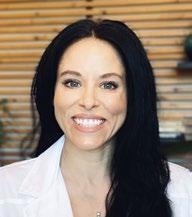
St. George Health & Wellness Magazine | September/October 2023 57
Strengthen Your Intuition
 By Brigit Atkin
By Brigit Atkin
About the Author Brigit Atkin–Brigit of Brightworks helps improve the lives of others facing challenges and difficulties. She is certified in the SimplyALIGN™ method and was trained by founder Carolyn Cooper herself. For more information, visit www.brightworksbybrigit.com.

In this world, there are many voices. They come at us from every direction, and oftentimes, they are contradictory, loud, and fearprovoking. It’s so easy to listen to an “expert” and abandon your own intuition.
Remember Y2K and the doomsday alarm that was sounding about the year 2000? In 1999, I was designing and subcontracting the house in which I currently live. Near the end of that year as January approached, I became increasingly fearful that the promised computer fiasco would put an end to my project, and I would be left with a house that was half built. There was nothing I could do except hope and pray the world wouldn’t end and continue to work on my house. Well, the new year came, and nothing happened. Life went on as usual (my husband was never worried about it; I should have listened to his calm voice), and our house was completed that spring.
I learned something important from that experience: fear and rumors do nothing more than disturb a person’s inner peace.
58 www.sghealthandwellnessmagazine.com
I was listening to so many outside voices that I had dimmed my own instincts. I determined that I would never allow that to happen to me again. *Note: There are times when danger is imminent, and you will need to act! Pay attention.
Heeding your intuition can keep you from harm. When I was six years old, I left the mall with my parents, but instead of taking my usual seat in the back behind my dad, I insisted on riding up front with my parents on the bench seat. My dad was hesitant, but I would not take “no” for an answer. As we turned out of the parking lot, a racing sports car hit us at a high rate of speed and spun our car around several times. We were hit in the exact spot where I would have been sitting—directly behind the driver’s seat.
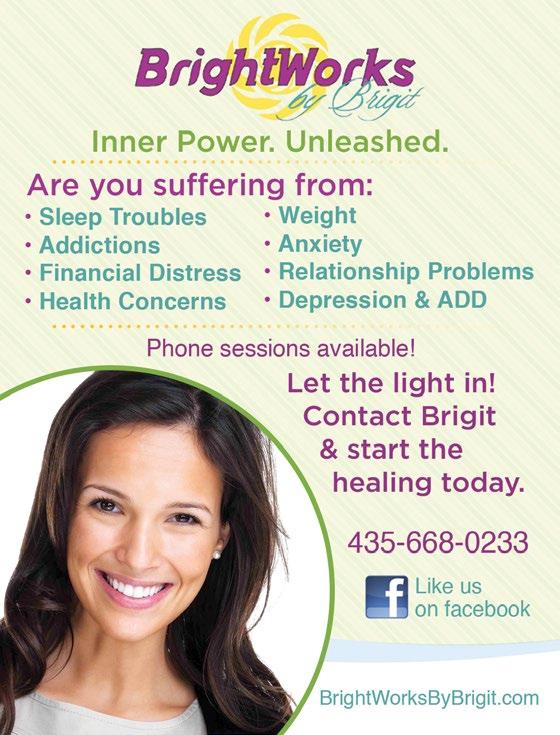
Intuition will help you in your everyday life, if you let it. A number of years ago, I was taking a business law course. One day, I was late for class and walked in as everyone was finishing a quiz. The quiz was timed, and as the professor handed me the test,
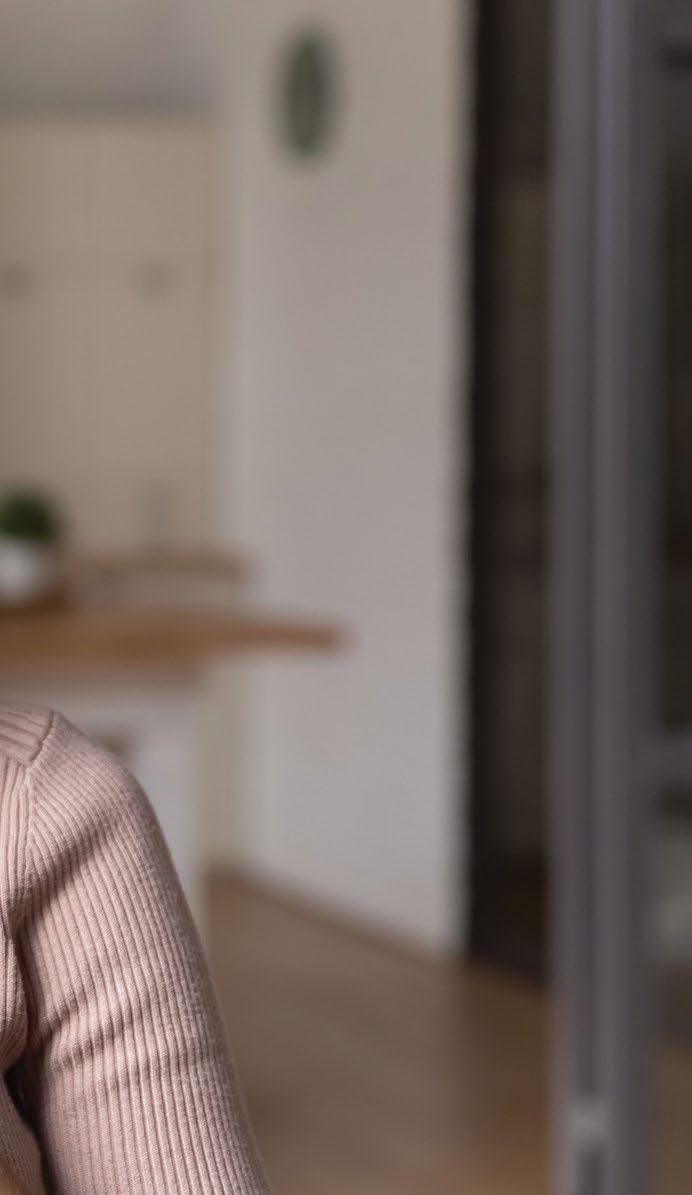
sympathy on his face, he said, “You have two minutes. Good luck!” As I sat down, I remembered the advice given by many of my teachers: it’s usually your first instinct that is correct. I had no time to doubt. I went through each question and wrote down the first answer that came to mind. And guess what—I got 100 percent on that quiz. My teachers were right: trust your first instinct.
I was visiting with one of my young neighbors last week. He’s eight years old. He told me of a time when he was little (smile), and he was with his family at an amusement park. They were in line for a ride, and he had the feeling he shouldn’t go on it. He told his mom but was assured he was safe. He said he got on the ride, and it made him sick. He wished he had acted on his instinct and stayed off the ride.
In big and small ways, your intuition is your friend. It is a gift that keeps you safe. Learn to trust it; always listen. If you are wrong at times, and we all are at some point, it is still an essential practice to listen to and act on that inner voice. You may be going against the grain. You might be disregarding someone’s well-meant advice. While you should consider the advice of others, take notice of how you feel about it. Does it feel right in your mind and in your heart? Does it make your stomach queasy? Does it cause confusion?
There will be times when you may feel you should take action, but it doesn’t make sense in your mind. Take your questions to a Higher Power. Then pause, listen, and proceed when you feel like doing so. Trust yourself. When you know, you know.
St. George Health & Wellness Magazine | September/October 2023 59
Tips for Enjoying Fall Hikes to the Fullest
 By Gini Grimsley, Director of Fitness Product, VASA Fitness
By Gini Grimsley, Director of Fitness Product, VASA Fitness
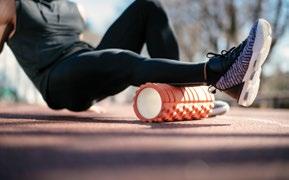


60 www.sghealthandwellnessmagazine.com
Hiking is more about the journey than the destination, and now that the weather is cooling off, there are many journeys to be taken on the hiking trails of Utah. However, before you meet your friends at the trailhead, you’ll want to be physically prepared to fully enjoy your adventures this fall.

While hiking is a workout in and of itself, there are a few gym-based exercises that you can do between hikes that will make your outings more enjoyable and less strenuous.
1. Use different types of leg-based cardio to get your heart, lungs, and legs ready for the journey ahead of you. Walking, jogging, running, stair climbing, and cycling are the easiest to rotate through to prevent boredom and overtraining in one area. The more variety you include in your weekly cardio workouts, the better you’ll be able to handle the ever changing terrain on a trail.
Start with ten to twenty minutes at a time, and once you’re able to knock out thirty consecutive minutes of cardio exercise, increase the intensity. This can be done by increasing the speed or incline on the treadmill, the resistance or RPM on the bike and elliptical, or the step speed on the stair climber.

2. Train up your backside. From the upper back to the glutes, these big muscle groups will help you stay upright and keep your pack (back or fanny) from irritating your low back and hips. Known as the posterior chain, the upper back, lats, glutes, and hamstrings also help with overall posture. With better posture comes better breathing, which is especially important at higher altitudes and during more strenuous activities.
A few good exercises to include in your strength workout each week are seated rows, glute bridges, RDLs (Romanian DeadLifts), lat pulldowns, and face pulls. Squats and lunges are also great to include since they utilize all the muscles of the lower body.
3. The warm-up is the most crucial piece of the entire puzzle when it comes to doing what you enjoy most. For both hiking and gym workouts, preparing the body to do work is one of the best ways, if not the best way, to avoid injury.
A good warm up should take ten minutes or less and move the body through ranges of motion that will be encountered in the workouts. Foam rolling is a great way to get the body to relax before stretching; rolling the body over the roller and hanging out on any tender spots helps the muscles relax.
Stretching and finding the deepest position with good posture will help improve range of motion during strength work. It will also create efficient movement during cardio. Once you’ve stretched one to two muscle groups, practicing the big movements you have in your strength work—without any weight—is crucial. The goal is to find the deepest range of motion you have available for that movement.
The last step of the warm-up is to get explosive! Jumping rope or medicine ball tosses are awesome ways to get the body working as a unit and ready for your workout.
These tips should help you stay safe, get strong, and help you enjoy those scenic hikes this fall.
St. George Health & Wellness Magazine | September/October 2023 61 About the Author Gini Grimsley is the Director of Fitness Product for VASA Fitness where she creates cutting-edge fitness programming for VASA’s clubs across eight states.
Retire on When You’re 6’11”, It’s Hard to Blend In PURPOSE
By Steve Wilson, Post Career Advisor
The relationship we have with our jobs is complicated. On one hand, a job is a source of pride and adds meaning to life—not to mention the critical role it plays in preventing homelessness and starvation. On the other hand, a job can sometimes be a burden, causing many to dream about retiring.
Most people who dream about retirement only imagine themselves going as far as walking out the door, figuring they’re smart enough to improvise after that. After all, how hard could it be? Retirement just has two steps, right?
Step 1: Stop going to work each day.
Step 2: Start doing whatever you want, whenever you want.
(At this point, the daydream is usually interrupted by the boss asking to see last month’s variance report.)
Lesson One: “Retiring from” something is easy; “retiring to” something isn’t.
Perhaps you’re a fan of professional sports. When an athlete announces his or her retirement, I often wonder, “ How would it be?” Consider that a long professional career usually lasts ten to fifteen years. This means that at retirement, most athletes are reaching the ripe old age of thirty-five or forty. Most have a home without a mortgage, several cars in the garage, fame, and many associated perks. And if that isn’t enough, after years of nutrition and exercise, they’re in excellent shape. Who wouldn’t have cause to wonder how it would be to retire in that situation?
My curiosity was satisfied in part by meeting a retired thirteen-year veteran of the National Basketball Association (NBA). My wife and I were visiting our daughter the day of our granddaughter’s sixth-grade assembly and accepted the invitation to attend. As we sat waiting for the program to begin, memories of my elementary school experiences came to mind, including the teachers who had influenced my life all those years ago.
When the sixth graders began to file into the auditorium, my daughter got my attention as our granddaughter Elin entered the room. I turned to look over my shoulder and saw energetic students filing into the room. Then something unexpected happened: a giant followed them, carefully ducking through the
door and unfolding his seven-foot frame. He appeared even taller as he stood in the middle of the sixth graders! I watched the way his class responded to him and couldn’t help thinking I’d like to know more.
I learned later that day that this teacher, Mr. Fred Roberts, was a retired professional basketball player who was beloved by his students. My daughter and granddaughter arranged for me to meet him and his wife at their home.
As I introduced myself, I explained I was writing a book for people who were beginning retirement, hoping to share “lessons for life after career” from those already retired. He graciously agreed to share his story but only after he told me about my amazing granddaughter, something I already knew. I was impressed that he wanted to focus attention on his student, not on himself.
Fred grew up in rural New Mexico, was recruited to play at Brigham Young University, was drafted into the NBA, played thirteen seasons, and ended his career with the Milwaukee Bucks.
“Why did you become a sixth grade teacher?” I asked.
“Well,” Fred began, “when I retired, I expected my future would just happen in one way or another, and I’d be successful. I had basketball related-opportunities, but I’d had enough basketball. A few business opportunities presented themselves, but I had no background or experience from which to evaluate. I was lost and didn’t have a clue what I was going to do or what I’d focus on.
“My situation was made more painful by the fact that my family and I chose to live in a neighborhood not far from where I played in college.” Fred struggled to find the right words as he described his difficulty pursuing a life after his career.“When you’re 6'11", it’s hard to blend in,” he continued. “Everywhere I went—to the grocery store, out to dinner, to the movies— people would come up to me and excitedly ask, ‘What are you going to do now?’ I had no answer.
“At first it was awkward; then it was embarrassing; then it was depressing.” Fred continued, “I’d watch my neighbors go to work each day pursuing dreams of a promotion, closing a deal, or saving to buy a boat or a cabin in the mountains. They looked
About the Author
Steve is the former CEO of St. George Regional Medical Center, St. George, Utah. He authored next—Redefining Retirement; Lessons for Life’s Transitions with Lisa G. Larson and speaks frequently to those preparing to leave their careers. He serves on the Board of the Institute for Continued Learning. His post career “hobby” is real estate investing, and he is Associate Broker for Utah First Property Management, a company his son Bryan founded. To contact Steve go to wilson.stg@gmail.com.

62 www.sghealthandwellnessmagazine.com
forward to spending time on weekends working on improvement projects around their house. As for me, I had enough money; I didn’t have to work again, my new house was paid for and fully furnished, and I couldn’t think of anything I wanted or didn’t already have. I was frustrated.”
Fred’s wife interjected and said, “It was worse than frustration. I’d come home to find Fred on the floor in the family room, rolling around, repeating over and over, ‘I’m worthless. I’m worthless.’”
Wow! What I was hearing was nothing like the way I had daydreamed about an athlete’s retirement. Even though he seemingly had everything, Fred was describing a nightmare. His story was a powerful reminder that living life without direction or purpose brings confusion, not comfort; anxiety, not bliss; and misery, not joy.
Lesson Two: The purpose you found in your career disappears when you retire; you must find a new purpose.
Now, the rest of the story.
Fred was invited to serve on the board at the private school his children attended (no doubt with an eye toward his gift-giving potential). In mid-year, the physical education teacher resigned.

Because Fred was an athlete and he had the time, the principal asked him if he’d step in as the PE teacher and finish the school year. Reluctantly, he accepted.
Fred loved the experience! That fall, he returned to the university to complete his degree in elementary education. Two years later, he was hired as a sixth grade teacher. When I met him, he was completing his thirteenth year of teaching.
During my own “life after career,” I have seen clearly the way a job becomes confused with a purpose in life. Often, when a person’s job ends, an emptiness is created that’s difficult if not impossible to fill, no matter how many trips are taken or rounds of golf are played. Ultimately, as Fred found out, purpose comes from making a difference in the lives of others.
Dr. Albert Schweitzer summarized what he learned over his lifetime with this simple statement: “The only ones among you who will be really happy are those who will have sought and found how to serve.” You will not have to look far to see where you can make a difference. Keep your eyes open! Your opportunity is out there. When found, you and the world will be better.
Lesson Three: Purpose comes from making a difference in the lives of others.
St. George Health & Wellness Magazine | September/October 2023 63
Applying the Law of the Harvest for Abundant Living
By Chris Eschler, Health and Well-Being Life Coach

What exactly is the law of the harvest, and what does it mean for you? The law of the harvest is a principle that states that we reap what we sow. Wonderful things happen when good seeds are sown, but this law can be devastating when it comes to bad seeds. Although it is considered farming jargon, the law of the harvest can be applied to all aspects of life. Once you understand that actions have consequences and choose to grow good seeds, you can create a rich, bountiful life of success and fulfillment. Applying the law of the harvest with steadfastness to all aspects of your life yields growth, multiplication, and abundant rewards.
Harvesting an abundant life is like the process of nurturing good seeds to take root. Just as it takes 72 to 110 days of proper care to plant and harvest corn, abundant living requires preparation, nourishment, reinforcement, and persistent endurance. Here are the guidelines:
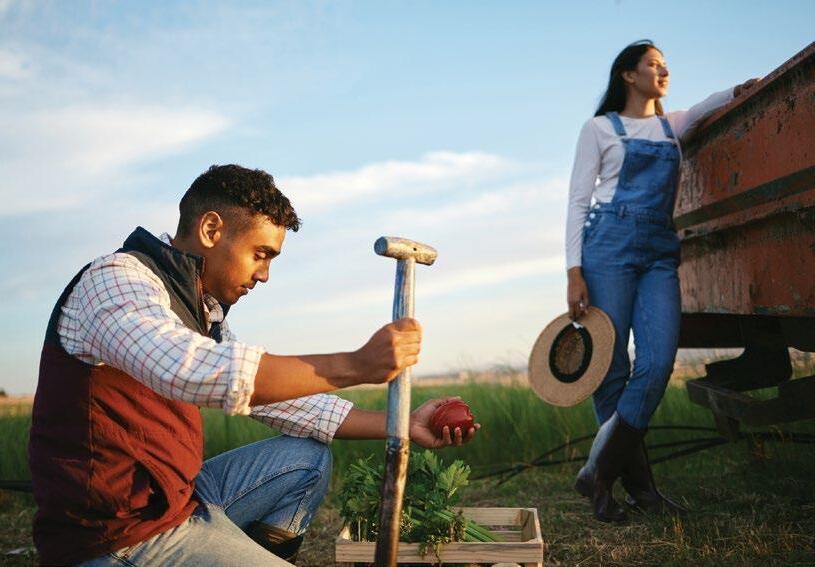
1. Do the groundwork; Prepare the soil.
It can be a struggle to grow a garden in desert soil. Ground work is essential. The gardening soil needs to be fertile and the elements of sunlight and water need to be available in the right amounts. The same goes for preparing the mind to achieve desired outcomes. A successful outcome cannot be manifested simply by repeating a mantra, such as “I will get a new laptop,” over and over. More than likely, frustration will be your reward and not the device.
There is more to achieving success than positive thinking. It is essential to expand your knowledge and take action in order to prepare nutrient-rich soil for your end result. Doing groundwork involves prayer/ meditation, thorough research, and seeking out trusted mentors.
About the Author
2. Plant the right seeds. Hone in on the desired outcome. If I want pickles, I’m going to plant cucumbers not zucchini, although they may look similar. It takes knowing what you’re after to plant the right seed. If I am constantly bickering with my spouse but want a harmonious relationship, I may decide it’s best to manage my anger rather than determining that we aren’t a good match and focusing on separation. I might choose to prepare the soil for growing a garden rich in tolerance by planting acceptance and gratitude to reap the benefits of a happy marriage.
3. Nourish to flourish. A garden needs continual nourishment and adequate growth time to reach an abundant harvest. The same is true for creating an abundant life; personal growth needs quality time and care.
4. Apply the stakes. Keep roots strong by staying grounded. Just as you would stake a tree seedling during the windy season, apply reinforcements when you face setbacks and unforeseen challenges.
During gale force winds, evaluate options; seek support or go about conquering your
challenges from another angle. An injured athlete might seek support from a physical therapist but can continue to maintain focus and weed out hopelessness by directing recovery time toward other areas of achievement: education and strengthening imbalances, for instance.
5. Weed your garden, and keep the pests out.
Regardless of how badly we want to harvest the fruit, weeds or pests inevitably pop into the garden. These “weeds” might be discouragement, negative thinking, or self-doubt. Grit is the tool necessary for weeding and chasing out adverse thoughts. Grit is a firmness of mind and spirit, the ability to overcome and persevere.
6. Enjoy the abundance!
Once you have harvested the fruits of your labor, savor the results. You have not just manifested your desired outcome, you have achieved abundance. There is more than enough to go around, so share the fruits and watch your harvest multiply!
Chris Eschler earned a BS in Marriage and Family Sciences at Brigham Young University-Idaho. As a life coach at Ascend Counseling and Wellness. Chris works with individuals to develop their skills and provides a safe, accepting environment for exploring a wide range of thoughts and feelings. Chris knows that you are the expert of your life and that she is simply a guide. She currently sees couples with her husband, licensed therapist Matt Eschler. Together they assist couples with all couples issues, specializing in high conflict couples work. To schedule an appointment with Chris for life coaching, call Ascend Counseling and Wellness at 435-688-1111 or visit https://ascendcw.com/.
64 www.sghealthandwellnessmagazine.com
Maximizing Retirement Savings
Managing Distributions to Control Market Volatility and Tax Liabilities
By Brandon DuCharme, AWMA®
Retirement planning involves not only accumulating wealth but also strategically managing distributions during your golden years. One crucial aspect often overlooked is the impact of market volatility and tax liabilities on your retirement savings. By understanding how to effectively manage where distributions come from, you can potentially save thousands of dollars, preserve your nest egg, and promote a more secure financial future. In this article, we’ll explore key strategies to navigate market volatility and increase tax efficiency during retirement.
Diversify Your Retirement Income Sources
When it comes to managing distributions in retirement, diversification is key. Relying solely on one income source, such as Social Security or a traditional pension, exposes you to potential risks. Consider building a diversified portfolio comprising various income streams, such as:
• Individual Retirement Accounts (IRAs) and 401(k) Plans. These tax-advantaged retirement accounts allow you to save and invest for retirement while deferring taxes. By strategically withdrawing from different types of accounts (traditional vs. Roth) based on your tax situation, you can potentially minimize your tax liability.
• Investment Portfolio. Stocks, bonds, real estate, and other investment vehicles can generate income during retirement. Balancing your portfolio between growth-oriented and incomeproducing assets can help manage market volatility while providing a steady income stream.
Utilize Tax-Smart Withdrawal Strategies
These might include:
• Tax Bracket Optimization. Understanding your tax bracket and utilizing tax-efficient withdrawal strategies can significantly
impact your retirement savings. For example, if you find yourself in a lower tax bracket during a particular year, consider withdrawing more from your traditional retirement accounts. Conversely, during years with higher tax liability, tap into your Roth accounts or other tax-free income sources.

• Managing Required Minimum Distributions (RMDs). RMDs from traditional retirement accounts, such as IRAs and 401(k) s, typically begin after age seventy-two. Failing to withdraw the required amount can result in penalties, while taking more than necessary can increase your tax liability. By planning ahead and strategically managing RMDs, you can minimize tax obligations and retain more of your savings.
Implement a Dynamic Asset Allocation Strategy
Market volatility during retirement can have a significant impact on your portfolio’s value. Implementing a dynamic asset allocation strategy that adjusts the allocation based on market conditions can help mitigate risk. Consider working with a financial advisor who can provide guidance on rebalancing your portfolio, shifting to more conservative investments during market downturns, and capitalizing on opportunities during upswings.
Regular Portfolio Reviews and Adjustments

Continuously monitoring your investment portfolio and retirement income strategy is crucial. Schedule regular reviews to assess your financial goals, risk tolerance, and market conditions. By making necessary adjustments, you can align your distribution strategy with your changing circumstances and safeguard your retirement savings.
Managing where distributions come from in retirement is a proactive approach to safeguarding your nest egg and potentially optimizing your financial outcomes. By diversifying your income sources, utilizing tax-smart withdrawal strategies, implementing a dynamic asset allocation strategy, and regularly reviewing your retirement plan, you can effectively navigate market volatility and reduce tax liabilities. Remember, consulting with a fiduciary financial advisor can provide personalized guidance tailored to your specific needs and help you make informed decisions that lead to long-term financial security.
St. George Health & Wellness Magazine | September/October 2023 65
Disclaimer: DuCharme Wealth Management & SCF Investment Advisors, Inc. are separate entities. Advisory services offered through SCF Investment Advisors, Inc. 10150 Meanley Drive, First Floor San Diego, CA 92131. (800) 955-2517. Fax (559) 456- 6109. www.scfsecurities.com. Local office 435-288-3396.
About the Author Branden DuCharme is a husband, father and accredited wealth management advisor (AWMA®) with DuCharme Wealth Management. He is also a graduate of Utah Tech University with a Bachelor Degree in Finance.
Pizza/Pasta Factory
Pasta Factory: 2 W. St. George Blvd. #8, St. George, UT 84770 | 435-674-3753

Pizza Factory: 2 W. St. George Blvd. #8, St. George, UT 84770 | 435-628-1234
Pizza Factory Express: 1930 W. Sunset Blvd., St. George, UT 84770 | 435-634-1234
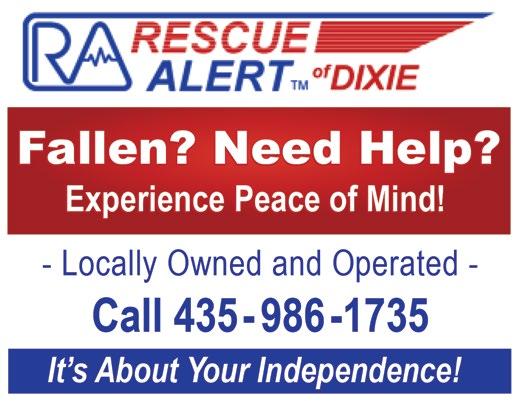
Pizza Factory Pineview: 2376 E. Red Cliffs Dr., St. George, UT 84790 | 435-688-2656


Pizza | Pasta | Dine-In | Take-Out | Salad Bar | $$
Delivery available at Pine View location only

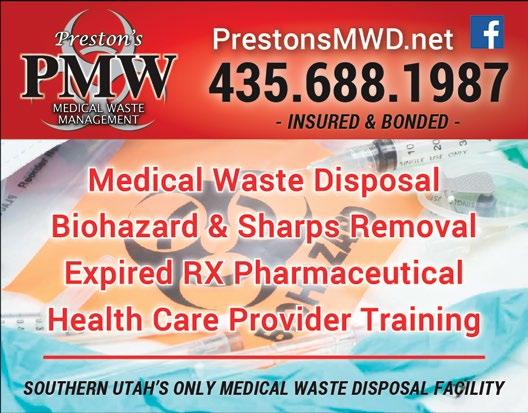

Mon.—Sat at 11:00 a.m.

The Pasta Factory, with its year-round, climate controlled outdoor patio dining wows with custom-made pasta, soups, sandwiches and salads. The Pizza Factory offers three locations with the best and freshest salad bar in town; homemade soups, sandwiches, famous bread twists and Southern Utah’s favorite pizza combinations.

Rescue Alert of Dixie, Providing Independence and Peace of Mind
fire department. The fire department was given the hidden key information. They assisted and cleared.
Richard fell and was unsure of his injuries. He was breathing but had a cut on his hand. Instructions were given on how to control the bleeding. Cindy (his daughter) was called to help. Once on the scene, she requested additional help. EMS responded, assisted, and cleared.
You may ask, “What can Rescue Alert of Dixie do for me or my loved one?”
First, they help provide independence. They help you to continue to live where you want to live and do the things you like to do.
Second, they provide peace of mind for those who wear the alert button and for those who care about them.
Third, they provide a variety of services to meet your needs that are customizable to your situation. They have in and around the home systems, mobile systems with GPS that work everywhere, fall detection options, and monitored medication dispensers.
What are some things that make Rescue Alert of Dixie different from their competitors?

Some of Rescue Alert’s competitors will only call 911 every time the button is pushed. Some have buttons that do not work outside of the home. Some have buttons that are not waterproof. Some never test their buttons with you; the only time you will know if it works is when you actually need some help, leaving you to trust that the button is charged and will connect to the response center.
Some companies’ response centers may not be in the U.S., so you may not be able to understand the person on the other end of the line when you are in need of help. Many response centers are not certified, and some companies purchase their units from overseas.
Here are a few examples of calls for help that Rescue Alert of Dixie response centers received in the past week:
Mary advised that she had fallen and needed help. Her first responder Jim (a friend) was called to help her get up. Jim arrived and assisted her; nothing further was needed.
Connie slipped and fell in the bathroom and hurt her lower back. She was breathing. Her first responder Julie (a neighbor) arrived on the scene and requested EMS. EMS assisted and transported Connie to the hospital.
Joan advised that she had fallen out of bed but was not injured. She requested that a call be placed to the

Shirley fell but was alert and breathing. Sue (her daughter) was called and reported no bleeding. Hospice was called. The hospice nurse responded and assisted. There was no need to transport. Sue reported that Shirley was fine and no other help was needed.
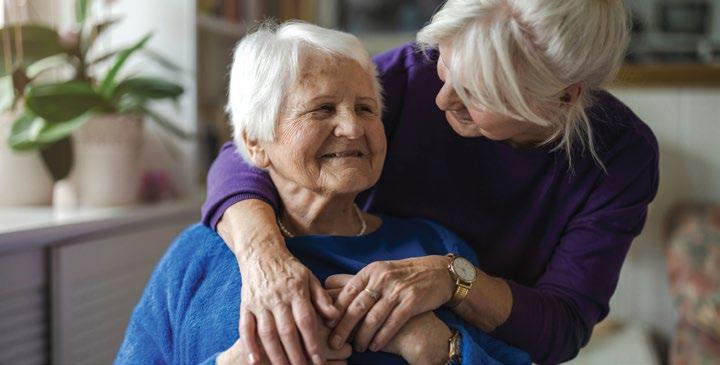
Other things that make Rescue Alert of Dixie different from their competitors:

• They manufacture their own units in Utah and have been doing so for over thirty years.

• They have two Emergency Medical Dispatcher (EMD) certified response centers, one in St. George and one in South Jordan, Utah.
• They have no long-term contracts.
• They give personalized service and test your system monthly,
• Their rates are very, very good! Shop local!
Experience Independence and peace of mind for you and your family with Rescue Alert of Dixie. Call 435-986-1735 or visit their website at www.rescuealertdixie.com.
St. George Health & Wellness Magazine | September/October 2023 67
EYE HEALTH: FACTS AND FICTIONS
By Dr. Nathan Anderson, MD
About the Author
Dr. Nathan Anderson, MD, is a board-certified ophthalmologist with additional fellowship training in oculoplastics. He specializes in cataract surgery as well as a variety of oculoplastic procedures including eyelid surgeries and tear duct surgeries. He is originally from South Jordan, Utah. He obtained his medical degree from Texas Tech University Health Science Center and completed his ophthalmology residency and fellowship at Wake Forest University in Winston-Salem, North Carolina, where he was the chief resident. He and his wife, Allie, are the proud parents of four children. Dr. Anderson enjoys spending time with his family, doing outdoor activities, and playing a variety of sports.

Eyes...We use them every day. The vision they provide is one of our most prized faculties. One recent study1 showed that 88 percent of people ranked vision as the most valuable of the traditional five senses.
Vision and our eyes’ importance in our daily lives is demonstrated in the idioms we use. We “catch someone’s eye” or see “eye to eye” with another. A mother has “eyes in the back of her head,” and her children are the “apple of her eye.”
We hear a lot about keeping our eyes healthy, but not everything you hear about your ocular health is true. Test your knowledge with these true/false statements:
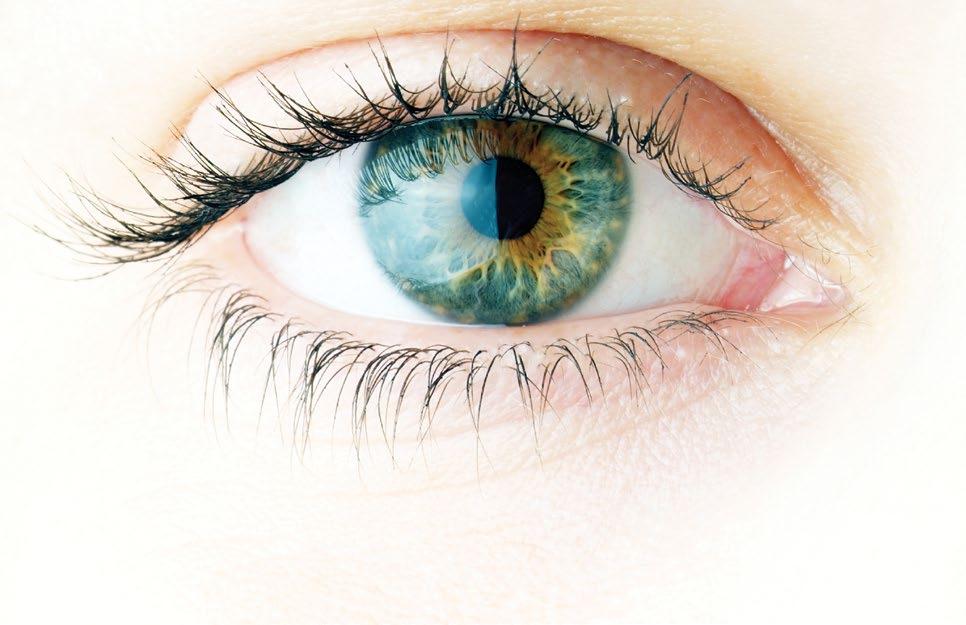
1. Older people who have trouble seeing should not use their eyes too much as they can “wear them out.”
Answer: false. A healthy eye has lifelong vision potential and cannot be “worn out” with use.
2. Children’s eyes will not be damaged by sitting close to the TV.
Answer: true. Children with healthy eyes will sit at a distance that is most comfortable for them and will not be harmed by any proximity to the television.
3. Once a cataract is removed, it will never grow back.
Answer: true. Cataract surgery removes the cloudy lens, restoring good vision to healthy eyes. Once removed, cataracts do not grow back. Cataracts are caused by age (among other factors). Cataract surgery is the most common surgery in the USA, with approximately three million surgeries performed yearly.
4. Contact lenses can be lost behind the eye.
Answer: false. The anatomy of the eye prevents a contact lens from moving behind it.
5. Blepharoplasty (surgery to remove excessive skin from the eyelid) is always considered a cosmetic surgery.
Answer: false. Eyelid surgery can be cosmetic, but is often considered functional and covered by insurance if the eyelid is blocking your peripheral vision or decreasing the amount of light entering the eye, making some tasks like driving or reading more difficult.
Maintaining good vision begins with regular appointments to monitor your ocular health. Eye care professionals and physicians can prescribe glasses and recommended lifestyle changes or medications, when needed. Sometimes, surgery (including removal of cataracts, elevation of the eyelids, or removing excessive skin from the eyelids) may be needed to help you maximize your vision so that you can continue to do the things you love.
The team at the St. George Eye Center looks forward to helping you with all your eye health needs. Visit them online at www.stgec.com, or call (435) 628-4507.
68 www.sghealthandwellnessmagazine.com
1Enoch
J;McDonald L;Jones L;Jones PR;Crabb DP; Evaluating whether sight is the most valued sense [Internet]. JAMA ophthalmology. U.S. National Library of Medicine; 2019 [cited 2023 Jul 21]. Available from: https://pubmed.ncbi.nlm.nih.gov/31580383/
Participating in the Performing Arts Helped Me Find Great Friends
 By Abby Terry, Dixie High School Junior
By Abby Terry, Dixie High School Junior

When I moved to St. George from Manti, Utah, almost five years ago, my biggest concern was finding new friends. The first school I attended after my family’s move here was Tonaquint Intermediate School, and I was thrown off guard by the differences I found between it and my previous school. In my mind, it seemed that everyone cared more about popularity and materialistic things than in making friends with the new kid in class; it was really tough for me.

Luckily, my mom got a job at Utah Conservatory of Performing Arts (COPA), a statewide performing arts company, and encouraged me to join. Through COPA, I learned a lot about music, dance, and theater. I also learned many life skills, like how to be confident, how to handle stress, and how to work well in a group. Most importantly, I was able to make many friends who helped me get through my first year of school.
Fast forward to my next challenge: I transferred from Tonaquint to Vista School in Ivins. I not only had to get used to a new school but I also had to find new school friends. Thankfully, I still had COPA, but I really wanted to find some friends at school so I would have someone to hang out with during the day.
At Vista, I joined another performing group called Vista Rising Stars (VRS). Just being able to practice and perform with other students who shared my same interests opened the way for me to find new friends. Through VRS and my school musicals at Vista, I was able to get to know people so much better and become really good friends with them. During my last year at Vista, I found that I looked forward to going to school every day. Although I had always loved performing
in theatrical productions, I recognized that COPA and VRS had helped “break the ice” for me and provided a way for me to find a group of friends that I loved and that I loved performing with!
A year ago, I found myself repeating the same cycle. I moved from Vista to Dixie High School, a much larger school with a whole new feeling. It was a difficult transition as many of my school friends peeled off to attend other high schools in the area. However, over the years, I had learned that I had the ability to make the change and to find new friends. My transition was made easier by amazing friends from COPA, who once again helped me through my first year of high school just as they did my first year of school in St. George.

As I approached the end of the school year last May, I knew that I wanted to do a summer musical. It had always helped me to make friends in the past, and it was always fun. I joined St. George Musical Theater’s production of Footloose, which has easily been one of my best decisions ever. Many of my old friends have joined me, and I have gotten to know them so much better. And of course, I have also made so many new friends.
Over the years and throughout the many transitions I’ve made, I have learned one thing: never be afraid to pursue your hopes, dreams, and goals. I came to St. George hoping to make new friends, but it was through the development of my talents and my participation in performing arts groups that I was able to make my hope a reality. In the future, I hope to continue performing in theater productions because there is so much to learn and so many new friends to meet!

St. George Health & Wellness Magazine | September/October 2023 69
Trimming Down?
The Science Behind Saving Dessert for Last
 By Koby Taylor, PharmD
By Koby Taylor, PharmD
Probably one of the hottest topics of our time is weight loss. I spend a great deal of time consulting and coaching my patients on this very subject. Whether it be a few pounds brought on by agerelated decrease of metabolism, unhealthy lifestyles, or genetic predispositions to obesity, weight loss and weight management are topics I discuss with patients daily.
As a culture, we’re exposed to “revolutionary” fad diets, exercise routines, surgical procedures, products, supplements, and pharmaceuticals, to name a few. And in recent months, thanks to advertising, our exposure to the aforementioned has proven to be no different.
Hot Weight Loss Medications/Products That Have Recently Hit the Market
Semaglutide, the active ingredient in brand-name drugs such as Ozempic, Wegovy, and Rybelsus, which were designed for the management of type 2 diabetes, have also been shown to be effective for weight loss. Semaglutide works by targeting GLP-1, which is a thirty or thirty-one amino acid long peptide hormone that lives in the gut. Triggered when you eat, this GLP-1 mechanism tells your brain when you’re full. In some people, this mechanism doesn’t work properly, so semaglutide will affect the GLP-1 and in a sense, turn on the “I’m full” mechanism.
I am often asked the following leading questions: How long can I use semaglutide? If I discontinue use, will the fat come back?
70 www.sghealthandwellnessmagazine.com
The length of time you can use semaglutide will vary from person to person. If you tolerate it well and are monitored, you may be able to stay on it indefinitely. I’d like to add that if you view this medication as a “tool,” rather than a fail-safe, to help you jump-start better eating habits with food and exercise and to help you get you to a healthier place mentally and physically, you won’t need to be on it indefinitely.
Once you’ve discontinued use, you may regain your weight. Keep in mind that for the length of time you have been taking it, this drug has been telling your body that you don’t need as much food or as many calories for survival. Once it has left your system, your body may start to feel as though it’s starving, which may cause you to eat more than you did while on it. Keypoint: this is also true with any fad diet or exercise routine. Anytime you stop, there is always that risk that your weight will come back. Please also recall what I wrote above about using this medication as a “tool.” If you are able to retrain your habits and your relationship with food, you’ll be able to overcome any weight gain brought on by stopping the use of semaglutide.
Semaglutide products, whether namebrand or compounded, will require a prescription, and you should be monitored by your healthcare provider.
Quick note about compounding: Patients are able to get semaglutide in compounded form. In particular, my pharmacy can create semaglutide lozenges in an oral form instead of an injectable form. There have been reports that compounded forms could be suspected of not being genuine. It is important to know your compounding pharmacy and its accreditations. Legitimate compounding pharmacies work extremely hard to gain and maintain accreditations and are under
radical ethical guidelines. So rest assured, legitimate compounding pharmacies will not jeopardize their standing by creating substandard medications.
Over-the-counter supplements, such as CM Core and HiPhenolic by Ortho Molecular Products, are showing a lot of promise for weight management. These supplements are something I have many of my patients try frequently, and they are showing promising signs of efficacy for weight loss.
CM Core contains berberine, a plantderived ingredient shown to boost metabolism and help regulate blood sugar as well as serve as a potent antioxidant. HiPhenolic contains a high concentration of polyphenols (plant-derived) and helps to support normal blood pressure levels, manage weight, and control appetite. What I love about these supplements is that they are over-the-counter, and many of my patients are reporting that while weight loss/management is one component, they have more energy and generally feel better throughout the day. These supplements aren’t designed to work as fast as semaglutide, but if you’re someone who wants to shed a few extra pounds, they may be a good alternative to explore.
The Meat and Potatoes of Food I have spoken with people who comment that they mainly eat salads and fruit, and yet they still have unwanted pounds. I have spoken to people who are very active, eat balanced meals, and either can’t lose weight or have gained weight. If either of these scenarios sounds familiar, here’s what we know about how our body processes food.
For the purpose of this article, I’m going to bypass naming all the hormones in
our body’s complex system and the roles they play with weight and instead, jump to one hormone in particular, and that is insulin. In brevity, insulin is created by the pancreas, and its sole function is to carry sugars we’ve consumed to blood cells for energy. If our body is insulin resistant, glucose can’t enter the cells as easily, which leads it to build up in the blood and may cause type 2 diabetes and/or obesity. In other words, when insulin levels are high, your body switches to a state of “fat storage,” and the fat that is stored is sugar that can’t be utilized.
Interestingly, just thinking of sweet treats can cause the body to create insulin and start its biological process. Isn’t that crazy? The same holds true for imagining your favorite meal; your mouth may start to salivate, and your body may literally get ready to ingest and digest this imaginary meal.
Can you counteract the insulin resistance response? Yes. Enjoy your dessert after your meal. While we’ve been brought up to think of dessert as saving the best for last, let’s now think of it this way: when you eat your meal consisting of proteins, fats, and fibers first, any sugars you consume afterward (even carbohydrates) now have a cushion that helps your body process sugar more slowly and efficiently. You may not even desire that sweet treat after all. If you’re curious about your blood sugar, there are wearable glucose monitors on the market. I highly recommend them to anyone who is on a weight loss journey. Your biggest asset will be your support and knowledge.
#FusionIsBetterMedicine
FUSION
Santa Clara (435) 703-9680
St. George (435) 656-2059
www.FusionSpecialtyPharmacy.com

About the Author
Koby Taylor, PharmD, is the owner and pharmacist of Fusion Pharmacy. Working as a retail pharmacist early in his career, Koby began to see that pharmacy patients needed to have access to available alternative medications. He realized that pharmacy in its truest form is compounding, and he wanted to be able to provide patients with customized medications. He also desired more personalized interactions with patients in order to truly help their health and well-being. To fulfill his passion for improving the health of patients and educating them about compounding, Koby opened the doors of Fusion Pharmacy in 2013. Today, Fusion is nationally accredited with PCAB. It is licensed in and ships to 32 states. Fusion is proud to have two locations to better serve the southern Utah community. Koby graduated from Brigham Young University with a degree in molecular biology in 1995 and from the University of Utah with his Doctorate of Pharmacy in 2000.

St. George Health & Wellness Magazine | September/October 2023 71
PHARMACY
Five Healthy Habits to Help Reduce Stress
Article Courtesy of Family Features
Between work, family obligations, and a constantly changing world, people in the United States are stressed. In fact, U.S. workers are among the most stressed in the world, according to a State of the Global Workplace study. While some stress is unavoidable and can be good for you, constant or chronic stress can have real consequences for your mental and physical health.
Chronic stress can increase your lifetime risk of heart disease and stroke. It can also lead to unhealthy habits like overeating, physical inactivity, and smoking while also increasing risk factors, including high blood pressure, depression, and anxiety. However, a scientific statement from the American Heart Association shows reducing stress and cultivating a positive mindset can improve health and well-being.
To help people understand the connection between stress and physical health, the American Heart Association offers these science-backed insights to help reduce chronic stress.
Stay Active
Exercise is one of the easiest ways to keep your body healthy and release stress. Physical activity is linked to lower risk of diseases, stronger bones and muscles, improved mental health and cognitive function, and lower risk of depression. It can also help increase energy and improve quality of sleep. The American Heart Association recommends adults get at least 150 minutes per week of moderate-intensity activity, seventy-five minutes of vigorous activity, or a combination.
Meditate
Incorporate meditation and mindfulness practices into your day to give yourself a few minutes to create some distance from daily stress. Studies show meditation can reduce blood pressure, improve sleep, support the immune system, and increase your ability to process information.
Practice Positivity
A positive mindset can improve overall health. A positive mindset can help you live longer, and happy individuals tend to sleep better, exercise more, eat better, and not smoke. Practice positive self-talk to help you stay calm. For instance, instead of saying that “everything is going wrong,” reframe the situation and say to yourself, “I can handle this if I take it one step at a time.”
Show Gratitude
Gratitude—or thankfulness—is a powerful tool that can reduce levels of depression and anxiety and improve sleep. Start by simply writing down three things you’re grateful for each day.
Find a Furry Friend
Having a pet may help you get more fit; lower stress, blood pressure, cholesterol, and blood sugar; and boost overall happiness and well-being. When you see, touch, hear, or talk to companion animals, you may feel a sense of goodwill, joy, nurturing, and happiness. At the same time, stress hormones are suppressed. Dog ownership is also associated with a lower risk of depression, according to research published by the American Heart Association.

Find more stress-management tips at Heart.org/stress.
Stress 101
Understanding stress is an important step in managing and reducing it. Consider these things to know about stress and how it could affect your life:
• Today, 1 in 3 adults in the U.S. report being worried or depressed.
• Higher levels of the stress hormone cortisol are linked to increased risk of high blood pressure and cardiovascular events like heart disease and stroke.
• The top sources of stress are money, work, family responsibilities, and health concerns.
• Work-related stress is associated with a 40 percent increased risk of cardiovascular disease, like heart attack and stroke.
72 www.sghealthandwellnessmagazine.com





St. George Health & Wellness Magazine | September/October 2023 73 SOUTHERN UTAH'S PREMIER RESOURCE FOR HEALTH, FITNESS, NUTRITION, FINANCE, MIND/BODY, ACTIVE AGING, AND CULTURE. For information about advertising rates, email diane.sghealth@gmail.com or visit the website at www.sghealthandwellnessmagazine.com. FITNESS NUTRITION CULTURE HEALTH ACTIVE AGING MIND/BODY ECONOMICS FAMILY MARCH/APRIL 2022 sghealthandwellnessmagazine.com INSIDE: The Importance of a Health Care Home / 30 Are Your Seasonal Allergies Driving You Crazy / 66 health&wellness st.george Food, Fun, and Friends Abound at the Fair See Page 16 Understanding Depression: Causes, Myths, and Treatments See Page 14 StGeorgeHW0222_rev07.indd NOVEMBER/DECEMBER 2022 sghealthandwellnessmagazine.com INSIDE: Connect to Your Community by Shopping Local / 18 2022 Jubilee of Trees Event to Support Behavioral Health Resources / 26 Recreation Therapy: Getting Comfortable with the Uncomfortable / 60 Staying Healthy During the Holidays See Page 14 FITNESS NUTRITION CULTURE HEALTH ACTIVE AGING MIND/BODY ECONOMICS FAMILY StGeorgeHW1022_rev02.indd 1 JANUARY/FEBRUARY 2023 sghealthandwellnessmagazine.com INSIDE: Alternative Therapies for Your Dog’s Health / 32 Winter Warm-Up Health Tips: Eat Well, Be Positive, Move More / 36 Change Your Mind, Change Your Life / 52 Make Volunteering Your New Year’s Resolution! See Page 14 FITNESS NUTRITION CULTURE HEALTH ACTIVE AGING MIND/BODY ECONOMICS FAMILY StGeorgeHW1222_rev04.indd 1 12/8/22 9:25 PM SEPTEMBER/OCTOBER 2022 sghealthandwellnessmagazine.com INSIDE: St. George Bicycle Collective Rolls On / 18 Commonly Asked Questions about IV Nutrient Therapy / 32 Graceful Aging with Cosmetic Facial Acupuncture / 52 Cover Story: Southwest Utah’s Top Three Fall Foliage Viewing Destinations See Page 14 FITNESS NUTRITION CULTURE HEALTH ACTIVE AGING MIND/BODY ECONOMICS FAMILY

TEETH-IN-A-DAY

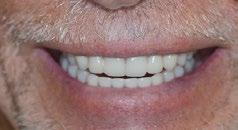
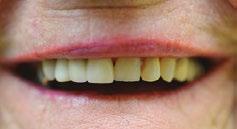
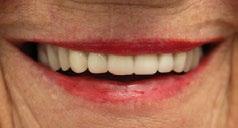

ALL-ON-4©

• M o re secu re a n d co m fo r ta bl e than t ra d i t i ona l dentu re s & fee l s l i ke n a tu ral teeth ( n o m o re dentu re s o re s )
• You’l l n ever h ave to wo rr y a bo ut yo ur teeth s l i p p i n g o r fa ll i n g ou t

• N o n eed for a d h e si ve
• Eat a n d s mi l e li ke you h ave h a d t h e s e teeth yo ur enti re l i fe
• Prese r ve s j aw bo n e a n d h el ps maintain a m o re yo uthfu l fa cial stru c tu re
• A b i l i ty to ta s te foo d
• I n c reased ch ewi n g c a pa ci ty : eat foo d s l i ke ap p l es, s tea k , co rn on t h e co b
• S a m e d ay fu l l a rch re s to rati o n w i th o nly fo ur im p l a nt s
BEFORE & AFTER
VOTED BEST OF SOUTHERN UTAH FIVE YEARS IN A ROW!

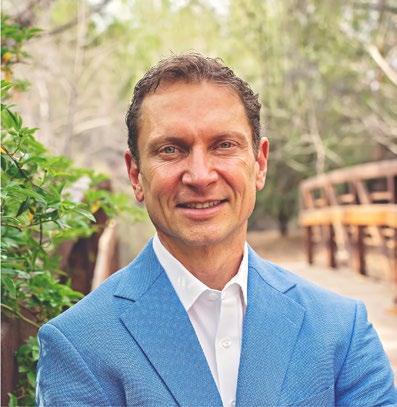
BEST MEDICAL FACILITY BEST ORAL & MAXILLOFACIAL SURGEON BEST DOCTOR
IN
1098 E Riverside Drive, St George, Utah 84790 (435) 628-1100 | UTAHOMS .COM
Dr. Shawn B. Davis Board Certified Oral & Maxillofacial Surgeon
A NEW, BEAUTIFUL SMILE
JUST ONE DAY !









































 Richard “Biff” Williams President of Dixie State University
Richard “Biff” Williams President of Dixie State University












 By Diane Del Toro
By Diane Del Toro




 By Matthew Linton, PhD
By Matthew Linton, PhD


















































































 By Jake Harber
By Jake Harber





























 By Brigit Atkin
By Brigit Atkin



 By Gini Grimsley, Director of Fitness Product, VASA Fitness
By Gini Grimsley, Director of Fitness Product, VASA Fitness



























 By Abby Terry, Dixie High School Junior
By Abby Terry, Dixie High School Junior




 By Koby Taylor, PharmD
By Koby Taylor, PharmD


















